EPA3545A(中文)
ASE快速溶剂萃取系统-ThermoFisherScientific

EPA方法3545A
OCP, OPP, BNA, TPH, PCDD, 除草剂和半挥发性物质
EPA方法6860
离子色谱/电喷射离子化/质谱检测水、泥土和固体废弃物中的高 氯酸盐
EPA方法8290A
高分辨气相色谱和高分辨质谱检测PCDDs和PCDFs
L00.00–34
食品中农残检测(德国)
SN/T 2593.1-2010 电子电气产品中多环芳烃的测定第1部分
微波 是 否 是 否 否 否
ASE350 是 是 是 是 是 是
最新Dionium™材质的池子和流路设计,极大地扩展了应用范围
全新设计的Dionium™池子和流路,具有化学惰性,能支持一定浓度的酸碱样品和试剂。
ASE Mojonnier
GC/MS测定脂肪(FAME)时应用的不同萃取技术比较
蛋黄酱
玉米片
** 省溶剂模式可以进一步减少溶剂消耗。
ASE 350特点
优点
可用250 mL或60 mL收集瓶
增加灵活性
Dionium™ — 化学惰性萃取池(选项)
可直接提取经强酸或强碱前处理过的样品, 扩大使用范围
新的快速泵(70 mL/min)
萃取速度更快
可选用各种体积的萃取池(1,5,10,22, 提高灵活性以满足许多应用样品的要求 34,66和100 ml)
萃取池准备 如图萃取前在33毫升萃取池中底部
加入一片滤膜,从底部至顶部依次加入 5克氧化铝、3克样品与15克硫酸钠混合 的混合物。
样品(3 g)+ NaSO4*(15 g) 氧化铝(5 g) 纤维素滤膜
ASE®萃取池装填示意图
样品准备 3克鱼肉与15克硫酸钠在研钵中混
合研磨,将混合物加入到萃取池中, 用2毫升正己烷淋洗研钵后加到萃取池 中,萃取池放到仪器上按照上面的萃取 条件萃取。接收的萃取液直接进行气相 色谱分析。
环境管理物质管理基准
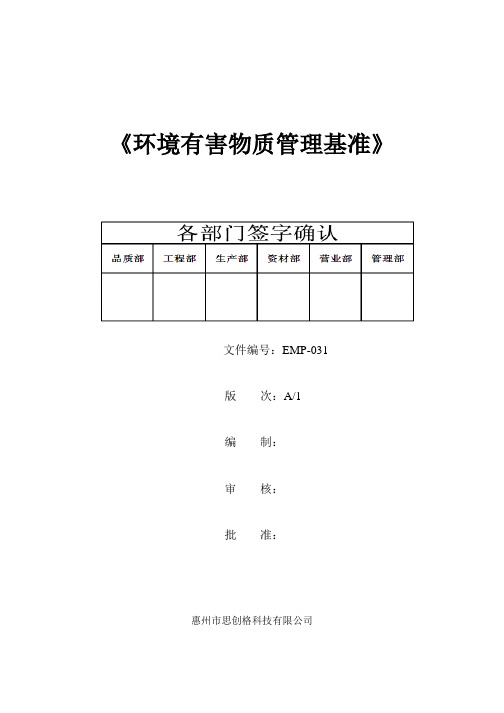
《环境有害物质管理基准》文件编号:EMP-031版次:A/1编制:审核:批准:惠州市思创格科技有限公司产品环境管理有害物质管理基准Ⅰ.Definition(定义)□指对环境管理物质的管理内容、精密规格、测试方法、管理期限等的管理。
□通过原材料和制品环境管理物质管理基准的实施,确保本公司的原材料和制品满足法律法规、客户和使用地的要求。
Ⅲ.Role & Responsibility(职责)Ⅳ.Procedure(流程)□Step1:材料出货:供应商出货原材料必须满足SCG《环境有害物质运营基准》。
出货时,须在原材料上或外箱上标识环境管理物质符合的标签。
□Step2:材料入库:对供应商出货品环境管理物质符合性标签进行检查。
如果没有相应标识,通知IQC进行退货处理。
拒绝存放至待检区。
□Step3:IQC检查:对供应商出货品环境管理物质符合性标签进行检查,判定是否合格。
如果要将外箱拆除存放的原材料,原材料领取时,需确认原材料的型号、名称和是否有环境管理物质符合性标签。
如果没有,拒绝领取。
在每个工序投入时,填写《不良异常联络单》,防止环境管理物质不符合物质的混入。
□Step5:第三方测试报告的提交:要求供应商每年最少提交1次第三方环境管理物质测试报告(有效期1年管理)。
□Step6:IQC对测试报告确认:确认供应商的测试报告的时效性和符合性。
符合性参照下记SCG有害物质管理基准。
不符合要求时,依赖供应商重新提出,并报告环境责任者。
□Step7:OQC出货检查:1.OQC出货检查时,必须对《物料卡》进行确认,确认原材料是否用错。
2.OQC出货检查时,必须对供应商第三方测试报告的时效性确认。
是否在有效期内。
3.若对上记两项有可疑时,需对制品送第三方测试机构进行验证。
Ⅴ.Sespection(管理基准):* 各物质的例外事项及化合物的具体内容请参照 Appendix 1, 2◆注意项目:a. Sn(锡)检出的情况需通过精密分析判断是否为3种有机锡(TBT,TPT,DBT)之一。
EN及EPA等系列标准 中文名称

BS EN1122:2001:湿法消解测定塑料中的镉BS EN 1122:2001:Plastics-determination of cadmium-Wet decomposition method方法3005A:FLAA,ICP方法分析酸式消解水中的总溶解金属METHOD 3005A:ACID DIGESTION OF WATERS FOR TOTAL RECVERABLE OR DISSOLVED METALS FOR ANALYSIS BY FLAA OR ICP SPECTROSCOPY方法3010A: FLAA,ICP方法分析酸式消解水样和蒸馏样中的总金属METHOD 3010A:ACID DIGESTION OF AQUEOUS SAMPLES AND EXTRACTS FOR TOTAL METALS FOR ANALYSIS BY FLAA OR ICP SPECTROSCOPY方法3015:微波酸式消解水样和蒸馏液METHOD 3015:MICROWAVE ASSISTED ACID DIGESTION OF AQUEOUS SAMPLES AND EXTRACTS 方法3020A:G FAA方法分析酸式消解水样和蒸馏样中的总金属METHOD 3010A:ACID DIGESTION OF AQUEOUS SAMPLES AND EXTRACTS FOR TOTAL METALS FOR ANALYSIS BY GFAA SPECTROSCOPY方法3031:AAS,ICP分析酸式消解石油中的金属元素METHOD 3031:ACID DIGESTION OF OILS FOR METALS ANALYSIS BY ATOMIC ABSORPTION OR ICP SPECTROMETRY方法3040A:石油,油脂,石蜡的消解程序METHOD 3040A:DISSOLUTION PROCEDURE FOR OILS, GREASES, OR WAXES方法3050B:沉淀物,淤泥,土壤的酸式消解METHOD 3050B:ACID DIGESTION OF SEDIMENTS, SLUDGES, AND SOILS方法3051:沉淀物,淤泥,土壤石油的微波酸式消解METHOD 3051:MICROWAVE ASSISTED ACID DIGESTION OF SEDIMENTS SLUDGES, SOILS, AND OILS方法3052:硅酸盐和有机质的微波酸式消解METHOD 3052:MICROWAVE ASSISTED ACID DIGESTION OF SILICEOUS AND ORGANICALLY BASED MATRICES方法3060:六价铬的碱式消解METHOD 3060A:ALKALINE DIGESTION FOR HEXAVALENT CHROMIUM方法3500B:有机萃取和样品制备METHOD 3500B:ORGANIC EXTRACTION AND SAMPLE PREPARATION方法3510C:分液漏斗的液—液萃取METHOD 3510C :SEPARATORY FUNNEL LIQUID-LIQUID EXTRACTION方法3520C:连续液-液萃取METHOD3520C:CONTINUOUS LIQUID-LIQUID EXTRACTION方法3535:固相萃取METHOD 3535:SOLID-PHASE EXTRACTION (SPE)方法3540C:索氏萃取SOXHLET EXTRACTION方法3541:AUTOMATED SOXHLET EXTRACTION方法3542:用方法0010收集半挥发性分析物的萃取物METHOD 3542:EXTRACTION OF SEMIVOLATILE ANALYTES COLLECTED USING METHOD 0010(MLDIFIED METHOD 5 SAMPLING TRAIN)方法3545:密闭流动萃取METHOD 3545:PRESSURIZED FLUID EXTRACTION (PFE)方法3546:微波萃取METHOD 3546:MICROWAVE EXTRACTION方法3550B:超声波萃取METHOD 3550B:ULTRASONIC EXTRACTION方法3560:超临界流动萃取石油中的中回收物METHOD 3560:SUPERCRITICAL FLUID EXTRACTION OF TOTAL RECOVERABLE PETROLEUM HYDROCARBONS方法3561:多环芳烃的超临界流动萃取METHOD 3561:SUPERCRITICAL FLUID EXTRACTION OF POLYNUCLEAR AROMATIC HYDROCARBONS方法3580:废物稀释METHOD 3580A:WASTE DILUTION方法3585:挥发性有机物的废物稀释METHOD 3585:WASTE DILUTION FOR VOLATILE ORGANICS方法3600C:清除METHOD 3600C:CLEANUP方法3610B:矾土的清除METHOD 3610B:ALUMINA CLEANUP方法3611B:柱状矾土的清除和石油废弃物的分离METHOD 3611B:ALUMINA COLUMN CLEANUP AND SEPARATION OF PETROLEUM WASTES方法3520B:硅酸镁的清除METHOD 3520B:FLORISIL CLEANUP方法3630C:硅胶的清除METHOD 3630C:SILICA GEL CLEANUP方法3640A:渗入硅胶的清除METHOD 3640A:GEL-PERMEATION CLEANUP方法3650B:酸碱的分离清除METHOD 3650B:ACID-BASE PARTITION CLEANUP方法3660B:硫磺的清除METHOD3660B:SULFUR CLEANUP方法3665A:硫酸,高锰酸的清除METHOD 3665A:SULFURIC ACID/PERMANGANATE CLEANUP方法3810:顶部空间METHOD 3810:HEADSPACE方法3820:16烷萃取和净化有机物的屏蔽METHOD 3820:HEXADECANE EXTRACTION AND SCREENING OF PURGEABLE ORGANICS方法7000A:原子吸收方法METHOD 7000A:ATOMIC ABSORPTION METHODS方法7130:镉(原子吸收,直接吸收)METHOD7130:CADMIUM (ATOMIC ABSORPTION, DIRECT ASPIRATION)方法7130A:镉(原子吸收,炉子技术)METHOD7131A:CADMIUM (ATOMIC ABSORPTION, FURNACE TECHNIQUE)方法7190:铬(原子吸收,直接吸收)METHOD7190:CHROMIUM (ATOMIC ABSORPTION, DIRECT ASPIRATION)方法7191:铬(原子吸收,炉子技术)METHOD7191:CHROMIUM (ATOMIC ABSORPTION, FURNACE TECHNIQUE)方法7196A:六价铬(比色)METHOD 7196A:CHROMIUM, HEXAVALENT (COLORIMETRIC)方法7420:铅(原子吸收,直接吸收)方法7420:LEAD (ATOMIC ABSORPTION, DIRECT ASPIRATION)方法7421:铅(原子吸收,炉子技术)METHOD 7421:LEAD (ATOMIC ABSORPTION, DIRECT ASPIRATION)方法7470A:废水中的汞(冷原子蒸汽技术)METHOD 7470A:MERCURY IN LIQUID WASTE (MANUAL COLD-VAPOR TECHNIQUE)方法7471A:固体和固体废弃物中的汞(冷原子蒸汽技术)METHOD 7471A:MERCURY IN SOLID OR SEMISOLID WASTE (MANUAL COLD-VAPOR TECHNIQUE) 方法7473 :热分解原子吸收光谱法测定固体和液体样品中的汞METHOD 7473:MERCURY IN SOLIDS AND SOLUTIONS BY THERMAL DECOMPODITION AMALGAMATION, AND ATOMIC ABSORPTION SPECTROPHOTOMETRY方法8000B:限定色谱分离METHOD 8000B:DETERMINATIVE CHROMATOGRAPHIC SEPARATIONS方法8081A:气相色谱分析有机氯沙虫剂METHOD 8081A:ORGANOCHLORINE PESTICIDES BY GAS CHROMATOGRAPHY方法8081B:气相色谱分析有机氯沙虫剂METHOD 8081B:ORGANOCHLORINE PESTICIDES BY GAS CHROMATOGRAPHY方法8082:气相色谱分析多氯联苯METHOD 8082:POLYCHLORINATED BIPHENYLS (PCBs) BY GAS CHROMATOGRAPHY方法8082A:气相色谱分析多氯联苯METHOD 8082A:POLYCHLORINA BIPHENYLS (PCBs) BY GAS CHROMATOGRAPHY方法8260B:气相色谱/质谱分析挥发性有机化合物METHOD 8260B:VOLATILE ORGANIC COMPOUNDS BY GAS CHROMATOGRAPHY/MASS SPECTROMETRY (GC/MS)。
EPA方法3545A(英文)
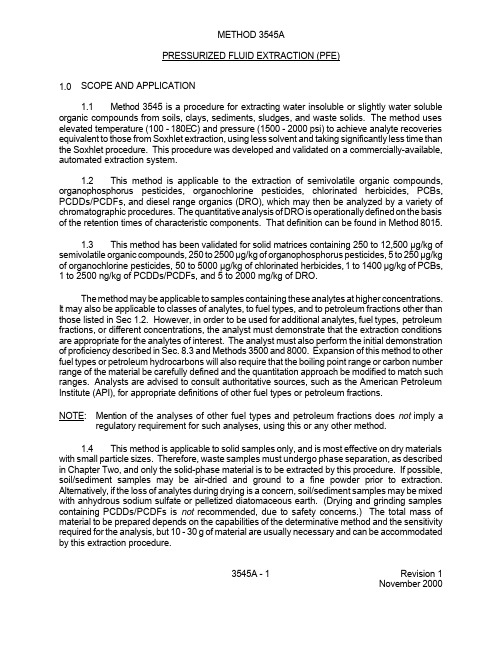
METHOD 3545APRESSURIZED FLUID EXTRACTION (PFE)1.0SCOPE AND APPLICATION1.1Method 3545 is a procedure for extracting water insoluble or slightly water soluble organic compounds from soils, clays, sediments, sludges, and waste solids. The method uses elevated temperature (100 - 180E C) and pressure (1500 - 2000 psi) to achieve analyte recoveries equivalent to those from Soxhlet extraction, using less solvent and taking significantly less time than the Soxhlet procedure. This procedure was developed and validated on a commercially-available, automated extraction system.1.2This method is applicable to the extraction of semivolatile organic compounds, organophosphorus pesticides, organochlorine pesticides, chlorinated herbicides, PCBs, PCDDs/PCDFs, and diesel range organics (DRO), which may then be analyzed by a variety of chromatographic procedures. The quantitative analysis of DRO is operationally defined on the basis of the retention times of characteristic components. That definition can be found in Method 8015.1.3This method has been validated for solid matrices containing 250 to 12,500 µg/kg of semivolatile organic compounds, 250 to 2500 µg/kg of organophosphorus pesticides, 5 to 250 µg/kg of organochlorine pesticides, 50 to 5000 µg/kg of chlorinated herbicides, 1 to 1400 µg/kg of PCBs, 1 to 2500 ng/kg of PCDDs/PCDFs, and 5 to 2000 mg/kg of DRO.The method may be applicable to samples containing these analytes at higher concentrations. It may also be applicable to classes of analytes, to fuel types, and to petroleum fractions other than those listed in Sec 1.2. However, in order to be used for additional analytes, fuel types, petroleum fractions, or different concentrations, the analyst must demonstrate that the extraction conditions are appropriate for the analytes of interest. The analyst must also perform the initial demonstration of proficiency described in Sec. 8.3 and Methods 3500 and 8000. Expansion of this method to other fuel types or petroleum hydrocarbons will also require that the boiling point range or carbon number range of the material be carefully defined and the quantitation approach be modified to match such ranges. Analysts are advised to consult authoritative sources, such as the American Petroleum Institute (API), for appropriate definitions of other fuel types or petroleum fractions.NOTE:Mention of the analyses of other fuel types and petroleum fractions does not imply a regulatory requirement for such analyses, using this or any other method.1.4This method is applicable to solid samples only, and is most effective on dry materials with small particle sizes. Therefore, waste samples must undergo phase separation, as described in Chapter Two, and only the solid-phase material is to be extracted by this procedure. If possible, soil/sediment samples may be air-dried and ground to a fine powder prior to extraction. Alternatively, if the loss of analytes during drying is a concern, soil/sediment samples may be mixed with anhydrous sodium sulfate or pelletized diatomaceous earth. (Drying and grinding samples containing PCDDs/PCDFs is not recommended, due to safety concerns.) The total mass of material to be prepared depends on the capabilities of the determinative method and the sensitivity required for the analysis, but 10 - 30 g of material are usually necessary and can be accommodated by this extraction procedure.3545A - 1Revision 1November 20001.5Prior to employing this method, analysts are advised to consult the base method for each type of procedure that may be employed in the overall analysis (e.g., Methods 3500, 3600, 5000, and 8000) for additional information on quality control procedures, development of QC acceptance criteria, calculations, and general guidance. Analysts also should consult the disclaimer statement at the front of the manual and the information in Chapter Two, Sec.2.1, for guidance on the intended flexibility in the choice of methods, apparatus, materials, reagents, and supplies, and on the responsibilities of the analyst for demonstrating that the techniques employed are appropriate for the analytes of interest, in the matrix of interest, and at the levels of concern.In addition, analysts and data users are advised that, except where explicitly specified in a regulation, the use of SW-846 methods is not mandatory in response to Federal testing requirements. The information contained in this method is provided by EPA as guidance to be used by the analyst and the regulated community in making judgments necessary to generate results that meet the data quality objectives for the intended application.1.6This method is restricted to use by or under the supervision of trained analysts. Each analyst must demonstrate the ability to generate acceptable results with this method.2.0SUMMARY OF METHOD2.1Samples are prepared for extraction either by air drying and grinding the sample, or by mixing the sample with anhydrous sodium sulfate or pelletized diatomaceous earth. The sample is then loaded into the extraction cell. Drying and grinding samples containing PCDDs/PCDFs is not recommended, due to safety concerns. Grinding may also be a concern for other more volatile analytes (see Sec. 7.1).2.2The extraction cell containing the sample is heated to the extraction temperature (see Sec. 7.8), pressurized with the appropriate solvent system, and extracted for 5 - 10 minutes (or as recommended by the instrument manufacturer). Multiple extractions are recommended for some groups of analytes. The solvent systems used for this procedure vary with the analytes of interest and are described in Sec. 5.7.2.3The solvent is collected away from the heated extraction vessel and allowed to cool. Since the extraction cells contain frits, no filtration of the extracts is needed. However, the extraction of very wet samples (e.g., $30% moisture) may require that the extract be dried with sodium sulfate.2.4The extract may be concentrated, if necessary, and, as needed, exchanged into a solvent compatible with the cleanup or determinative step being employed.3.0INTERFERENCES3.1Refer to Method 3500.3.2If necessary, Florisil and/or sulfur cleanup procedures may be employed. In such cases, proceed with Method 3620 and/or Method 3660.3545A - 2Revision 1November 20003.3Samples for PCDD/PCDF analysis should be subjected to the various cleanup procedures described in the determinative methods (8280 and 8290).3.4Samples for the analysis of DRO may be subjected to a sodium sulfate/silica gel cleanup procedure to remove non-petroleum hydrocarbon interferences (see Sec. 7.12.2).4.0APPARATUS AND MATERIALS4.1Pressurized fluid extraction device4.1.1Dionex Accelerated Solvent Extractor® or Supelco SFE-400 withappropriately-sized extraction cells. Currently, cells are available that will accommodate 1-g, 5-g, 10-g, 20-g and 30-g samples. Cells should be made of stainless steel or other material capable of withstanding the pressure requirements (2000+ psi) necessary for this procedure.4.1.2Other system designs may be employed, provided that adequateperformance can be demonstrated for the analytes and matrices of interest.4.2Apparatus for determining percent dry weight4.2.1Oven - drying4.2.2Desiccator4.2.3Crucibles - porcelain or disposable aluminum4.3Apparatus for grinding - capable of reducing particle size to < 1 mm.4.4Analytical balance - capable of weighing to 0.01 g.4.5Vials for collection of extracts - 40-mL or 60-mL, pre-cleaned, open top screw-cap with PTFE-lined silicone septum (Dionex 049459, 049460, 049461, 049462 or equivalent).4.6Filter disk - 1.983-cm, cellulose or glass fiber (Dionex 049458 or 047017).4.7Cell cap sealing disk (Dionex 49454, 49455, or equivalent).5.0REAGENTS5.1Reagent-grade chemicals shall be used in all tests. Unless otherwise indicated, it is intended that all reagents shall conform to the specifications of the Committee on Analytical Reagents of the American Chemical Society, where such specifications are available. Other grades may be used, provided it is first ascertained that the reagent is of sufficiently high purity to permit its use without lessening the accuracy of the determination.3545A - 3Revision 1November 20003545A - 4Revision 1November 20005.2Organic-free reagent water. All references to water in this method refer to organic-free reagent water, as defined in Chapter One.5.3Drying agents5.3.1Sodium sulfate (granular anhydrous), Na 2SO 4.5.3.2Pelletized diatomaceous earth.5.3.3The drying agents should be purified by heating at 400E C for 4 hours in ashallow tray, or by extraction with methylene chloride. If extraction with methylene chloride is employed, then a reagent blank should be prepared to demonstrate that the drying agent is free of interferences.5.3.4See the note in Sec. 7.6 regarding the use of drying agents for very wetsamples.5.4Quartz sand - Clean sand may be used to facilitate grinding of some sample matrices,to fill void volumes in the extraction cell, and to increase the flow of solvent through the sample. It may be prepared as described in Sec. 5.3.3. Sand with a small particle size should not be used,as the fine particles can stick to the threads of the cell, resulting in leaks and damage to the threads.Ottawa sand, with a particle size of 20-30 mesh, has been found to work well and it is readily available from suppliers (e.g., Fisher Scientific, S23-3, or equivalent).5.5Silica gel for DRO cleanup - 100/200 mesh, Davisil sorbent, Grade 634 (60 A pores)or equivalent. Before use, activate for at least 16 h at 130E C in a shallow glass tray, loosely covered with foil.5.6Acids5.6.1Phosphoric acid solution used for extraction of chlorinated herbicides (seeSec. 5.7.5). Prepare a 1:1 (v/v) solution of 85% phosphoric acid (H 3PO 4) in organic-free reagent water.5.6.2Trifluoroacetic acid solution used for extraction of chlorinated herbicides (seeSec. 5.7.5). Prepare a 1% (v/v) solution of trifluoroacetic acid in acetonitrile.5.6.3Glacial acetic acid used for extraction of PCDDs/PCDFs (see Sec. 5.7.6).5.7Extraction solventsThe choice of extraction solvent will depend on the analytes of interest and no single solvent is universally applicable to all analyte groups. Whatever solvent system is employed, including those specifically listed in this method, the analyst must demonstrate adequate performance for the analytes of interest, at the levels of interest. At a minimum, such a demonstration will encompass the initial demonstration of proficiency described in Sec. 8.2 of Method 3500, using a clean reference matrix. Method 8000 describes procedures that may be used to develop performance criteria for such demonstrations as well as for matrix spike and laboratory control sample results.3545A - 5Revision 1November 2000Many of the solvent systems described below include the combination of a water-miscible solvent, such as acetone, and a water-immiscible solvent, such as methylene chloride or hexane.The purpose of the water-miscible solvent is to facilitate the extraction of wet solids by allowing the mixed solvent to penetrate the layer of water on the surface of the solid particles. The water-immiscible solvent extracts organic compounds with similar polarities. Thus, a non-polar solvent such as hexane is often used for non-polar analytes such as PCBs, while a polar solvent like methylene chloride may be used for polar analytes. The polarity of acetone may also help extract polar analytes in mixed solvent systems.CAUTION:When extracting very wet samples (e.g., $30% moisture), large amounts of water maybe collected along with the extracts if a mixed solvent containing acetone is used (seethe note following Sec. 7.6).All solvents should be pesticide quality or equivalent.5.7.1Organochlorine pesticides may be extracted with acetone/hexane (1:1, v/v),CH 3COCH 3/C 6H 14, or acetone/methylene chloride (1:1,v/v), CH 3COCH 3/CH 2Cl 2 .5.7.2Semivolatile organics may be extracted with acetone/methylene chloride (1:1,v/v), CH 3COCH 3/CH 2Cl 2, or acetone/hexane (1:1, v/v), CH 3COCH 3/C 6H 14.5.7.3PCBs may be extracted with acetone/hexane (1:1, v/v), CH 3COCH 3/C 6H 14,acetone/methylene chloride (1:1, v/v), CH 3COCH 3/CH 2Cl 2, or hexane, C 6H 14.5.7.4Organophosphorus pesticides may be extracted with methylene chloride,CH 2Cl 2, or acetone/methylene chloride (1:1, v/v), CH 3COCH 3/CH 2Cl 2.5.7.5Chlorinated herbicides may be extracted with an acetone/methylenechloride/phosphoric acid solution (250:125:15, v/v/v), CH 3COCH 3/CH 2Cl 2/H 3PO 4, or an acetone/methylene chloride/trifluoroacetic acid solution (250:125:1, v/v/v),CH 3COCH 3/CH 2Cl 2/CF 3COOH. (If the second option is used, the trifluoroacetic acid solution should be prepared by mixing 1% trifluoroacetic acid in acetonitrile.) Make fresh solutions before each batch of extractions.5.7.6PCDDs/PCDFs may be extracted with toluene, C 6H 5CH 3. Fly ash samplesto be extracted for PCDDs/PCDFs may be extracted with a toluene/acetic acid solution (5%v/v glacial acetic acid in toluene) in lieu of the HCl pretreatment described in Methods 8280 and 8290.5.7.7DRO may be extracted with acetone/methylene chloride (1:1, v/v),CH 3COCH 3/CH 2Cl 2, acetone/hexane (1:1, v/v), CH 3COCH 3/C 6H 14, or acetone/heptane (1:1,v/v), CH 3COCH 3/C 7H 16.5.7.8Other solvent systems may be employed, provided that the analyst candemonstrate adequate performance for the analytes of interest in the sample matrix (see Method 3500, Sec. 8.0).5.8High-purity gases such as nitrogen, carbon dioxide, or helium are used to purge and/or pressurize the extraction cell. Follow the instrument manufacturer's recommendation for the choice of gases.6.0SAMPLE COLLECTION, PRESERVATION, AND HANDLINGSee the introductory material to this chapter, Organic Analysis, Sec. 4.1, and Method 3500.7.0PROCEDURE7.1Sample preparationAs is the case for many other extraction procedures, pressurized fluid extraction performs best on dry, finely-ground solids. However, the processes of drying the sample and grinding the sample both involve the potential for loss of analytes, introduction of other contaminants into the sample, contamination of the laboratory environment, and exposure of the analyst to environmental contaminants. Therefore, the analyst must determine the most appropriate approach to be used for each combination of sample matrix and analytes of interest, balancing analytical accuracy, practicality, and worker safety. No single approach should be expected to work for all matrices or analytes. The following sections describe the general procedures that may be applied to different matrices, types of solid samples, and/or samples for specific classes of analytes.NOTE:Drying or grinding of samples for PCDDs/PCDFs generally are not recommended, due to safety concerns with samples containing these analytes.7.1.1Sediment/wet soil samples - Decant and discard any water layer on asediment sample. Discard any foreign objects such as sticks, leaves, and rocks. Mix the sample thoroughly, especially composited samples. When practical, air dry the sample at room temperature for 48 hours in a glass tray or on hexane-rinsed aluminum foil. See the note in Sec . 7.6.NOTE:Dry, finely-ground soil/sediment allows the best extraction efficiency for nonvolatile, nonpolar organics, e.g., 4,4'-DDT, PCBs, etc. Air-drying may not be appropriate forthe analysis of the more volatile organochlorine pesticides (e.g., the BHCs) or themore volatile of the semivolatile organics, because of losses during the dryingprocess. Oven-drying is not recommended for any analytes.7.1.2Waste samples - Multiphase waste samples must be prepared by the phaseseparation method in Chapter Two before extraction. This extraction procedure is for solids only.7.1.3Dry sediment/soil and dry waste samples amenable to grinding - Visuallyinspect the samples to determine approximate particle size. Many samples do not require any pretreatment prior to loading into the extraction cells other than mixing with diatomaceous earth. If the sample particle size is too large, grind or otherwise reduce the particle size of the3545A - 6Revision 1November 2000waste so that it either passes through a 1-mm sieve or can be extruded through a 1-mm hole, using the procedures described in Sec. 7.2.NOTE:The note in Sec. 7.1.1 also applies to the grinding process.7.1.4Gummy, fibrous, or oily materials not amenable to grinding should be cut,shredded, or otherwise reduced in size to allow mixing and maximum exposure of the sample surfaces for the extraction. They may also be mixed with drying agents to make them more amenable to grinding, as described in Sec. 7.2.7.1.5Solid samples for PCDD/PCDF analysis are generally carefully mixed,breaking up lumps with a spatula or other suitable tool.7.1.6Fly ash samples may be pretreated with an HCl solution prior to extraction(see Sec. 7 of Method 8280 or 8290). Alternatively, they may be extracted with the toluene/acetic acid solution described in Sec. 5.7.6. Fly ash samples do not require grinding.7.2Sample grinding7.2.1If the sample was air-dried (see Sec. 7.1.1) or was already dry enough forgrinding (see Sec. 7.1.3), then grind at least enough of the sample to yield the sample weight needed for the determinative method (usually 10 - 30 g). Grind the sample until it passes through a 10-mesh sieve.WARNING:Grinding of samples for PCDDs/PCDFs generally is not recommended, due to safety concerns with samples containing these analytes.7.2.2For gummy, fibrous, or oily materials, the analyst may add anhydrous sodiumsulfate, pelletized diatomaceous earth, sand, or other clean, dry reagents to the sample to make it more amenable to grinding. Grind the sample until it passes through a 10-mesh sieve.NOTE:If this approach is used, then in order to obtain accurate results, the weights of the sample aliquot and the drying agent must be carefully measured prior to mixing andthe total volume of the combined material must not exceed the capacity of theextraction cell. Otherwise, it will not be possible to determine the weight of the actualfield sample that was extracted.7.2.3Disassemble the grinder between samples, according to the manufacturer'sinstructions, and wash it with soap and water, followed by acetone and hexane rinses. Other cleaning procedures may be employed, provided that the analyst can demonstrate through the analysis of method blanks that the procedures are effective at preventing cross-contamination between samples.7.3Weighing the sampleIf the sample was ground, then weigh the appropriate aliquot of the ground sample needed for the determinative method and the sensitivity needed for the project into the extraction cell of the appropriate size for the aliquot plus any other reagents, or into another clean container. For3545A - 7Revision 1November 20003545A - 8Revision 1November 2000%dry weight 'g of dry sample g of sample×100samples for PCDD/PCDF analysis and other samples that have not been ground, weigh the appropriate aliquot of the well-homogenized sample into the extraction cell or other clean container.NOTE:The weight of a specific sample that a cell will contain depends on the bulk density of thesample and the amount of drying agent that must be added to the sample in order to make it suitable for extraction. Generally, an 11-mL cell will hold about 10 g of material, a 22-mL cell will hold about 20 g of material, and a 33-mL cell will hold about 30 g of material.Analysts should ensure that the sample aliquot extracted is large enough to provide the necessary sensitivity and choose the extraction cell size accordingly.If the sample is weighed in the extraction cell, then prepare the cell by placing a disposable cellulose or glass fiber filter in the cell outlet before adding the sample. Record the weight of the empty cell and the weight of the sample and the cell. Determine the weight of the sample by difference.7.4Determination of percent dry weight - When sample results are to be calculated on a dry weight basis, a second portion of sample should be weighed at the same time as the portion used for analytical determination.WARNING:The drying oven should be contained in a hood or vented. Significant laboratorycontamination may result from drying a heavily contaminated sample.Immediately after weighing the sample for extraction, weigh 5 - 10 g of the sample into a tared crucible. Dry this aliquot overnight at 105E C. Allow to cool in a desiccator before weighing.Calculate the % dry weight as follows:7.5Adding surrogates and other spiked compoundsAdd the surrogates (or labeled internal standards for PCDDs/PCDFs) listed in the determinative method to each sample in its extraction cell or in another clean container. Consult Method 3500 and the determinative method for information on appropriate surrogates and internal standards.Stir the mixture well and allow it to stand while the spiking solvent evaporates. Add the matrix spike/matrix spike duplicate compounds listed in the determinative method to the two additional aliquots of the sample selected for spiking.NOTE:The utility of the data for the matrix spike compounds, as well as the surrogates and anyother compounds spiked into any sample, depends on the degree to which the spiked compounds mimic the compounds already present in a field sample. Therefore, it is CRITICAL that any compounds added to a sample, including the surrogates, are added to the sample aliquot PRIOR TO any additional processing steps. This means that the matrix spike and surrogate compounds should be added to the sample PRIOR TO adding drying agents such as sodium sulfate to solid samples. It is also CRITICAL that the spiked compounds be in the same chemical form as the target compounds, e.g., DO NOT spikethe methyl esters of the phenoxy acid herbicides, but rather, spike the phenoxy acids themselves.7.6After spiking the surrogates or other compounds, if needed, add sufficient drying agent to the sample in order to make it suitable for extraction (see the note in Sec. 7.3). Some samples may not require any drying agent. Very wet samples may require twice the weight of the sample in drying agent. Carefully mix the sample and the drying agent in the cell, using a clean spatula or other suitable tool.If the sample was spiked in a container other than the extraction cell, then add a weighed amount of the drying agent to that container and carefully mix it with the sample. Weigh the empty cell, transfer the mixture to the cell, and reweigh the cell. Determine the weight of the sample plus the drying agent by difference. Determine the weight of the actual sample by assuming that the mixture that was transferred to the cell was composed of the original ratio of sample material and drying agent (e.g., if the mixture was made of 10 g of sample and 12 g of drying agent, then assume that 10/22ths of material in the cell is the original sample).NOTE:The use of sodium sulfate as a drying agent with very wet samples (e.g., $30% moisture) can lead to clogging of the frits in the cell with recrystallized sodium sulfate, particularly ifa mixed solvent containing acetone is used. In these cases, pelletized diatomaceousearth and not sodium sulfate should be used as a drying agent. (Alternatively, pelletized diatomaceous earth may be used as a drying agent in the cell in place of sodium sulfate for all levels of moisture.) For very wet samples, regardless of the drying agent used, it will be necessary to add sodium sulfate to the vials after collection and to pass the extracts through a drying column or drying cartridge to dry the extract completely. Due to the high temperatures used, more water will be coextracted than with other extraction procedures. The analyst must make sure that adequate attention is given to rinsing the sodium sulfate in the vial and the clean up column to ensure good analyte recovery (see Secs. 7.12.1 and 7.12.2).If no drying agent is needed, then clean sand may be used to fill any void volume in the extraction cells. Follow the manufacturer's recommendations regarding the need to fill void volumes.NOTE:Since the sand is not intended to dry the sample, it need not be mixed with the sample, but can be placed at one end of the cell.7.7Seal the extraction cell according to the manufacturer's instructions. Use disposable cellulose or glass fiber filters in the cell outlets. Place the extraction cell into the instrument or autosampler tray, as described by the instrument manufacturer.7.8Place a precleaned collection vessel in the instrument for each sample, as described by the instrument manufacturer. The total volume of the collected extract will depend on the specific instrumentation and the extraction procedure recommended by the manufacturer and may range from 0.5 to 1.4 times the volume of the extraction cell. Ensure that the collection vessel is sufficiently large to hold the extract.NOTE:The volume of solvent used for each extraction is a function of the size of the extraction cell, not the weight of the sample. Consult the manufacturer's instructions for the3545A - 9Revision 1November 2000appropriate volume of solvent to employ for a given cell size and the necessary collection vessel volume.7.9Recommended extraction conditionsSee the introductory material in Sec. 5.7 regarding the choice of solvents.7.9.1Semivolatiles, organophosphorus pesticides, organochlorine pesticides, herbicides, and PCBsOven temperature:100E CPressure:1500 - 2000 psiStatic time: 5 min (after 5-min pre-heat equilibration)Flush volume:60% of the cell volumeNitrogen purge:60 sec at 150 psi (purge time may be extended for larger cells) Static Cycles:17.9.2PCDDs/PCDFsOven temperature:150 - 175E CPressure:1500 - 2000 psiStatic time: 5 -10 min (after 7- to 8-min pre-heat equilibration)Flush volume:60 - 75% of the cell volumeNitrogen purge:60 sec at 150 psi (purge time may be extended for larger cells) Static Cycles: 2 or 37.9.3DROOven temperature:175E CPressure:1500 - 2000 psiStatic time: 5 -10 min (after 7- to 8-min pre-heat equilibration)Flush volume:60 - 75% of the cell volumeNitrogen purge:60 sec at 150 psi (purge time may be extended for larger cells) Static Cycles:17.9.4Optimize the conditions, as needed, according to the manufacturer's instructions. In general, the pressure is not a critical parameter, as the purpose of pressurizing the extraction cell is to prevent the solvent from boiling at the extraction temperature and to ensure that the solvent remains in intimate contact with the sample. Any pressure in the range of 1500 - 2000 psi should suffice.3545A - 10Revision 1November 20007.9.5Once established, the same pressure should be used for all samplesextracted for the same analysis type.7.10Begin the extraction according to the manufacturer's instructions. For PCDD/PCDF extraction, 2 to 3 static extractions are recommended.7.11Collect each extract in a clean vial (see Sec. 7.8). Generally, the extracts are near room temperature upon collection.7.12The extract is now ready for concentration, cleanup, or analysis, depending on the extent of interferants and the determinative method to be employed. Refer to Method 3600 for guidance on selecting appropriate cleanup methods. Excess water present in extracts may be removed by filtering the extract through a bed of anhydrous sodium sulfate. Certain cleanup and/or determinative methods may require a solvent exchange prior to cleanup and/or sample analysis.7.12.1When extracting very wet samples (e.g., $30% moisture) with acetone-containing solvents, it is often necessary to add sodium sulfate to the collection vials after extraction to remove excess water. Amounts of 1 to 10 grams may need to be added depending on the amount of water in the sample. It is important that the vial and sodium sulfate be thoroughly rinsed to ensure complete analyte recovery.7.12.2For DRO-containing samples, a column cleanup procedure may benecessary to remove coextracted interferants. Place 2-10 g of activated silica gel (Sec. 5.5) in a 10-mm ID glass chromatographic column and top it with 4 to 5 cm of sodium sulfate (see Method 3630 for guidance). The amount of silica gel needed will depend on the size of sample extracted. The amount of sodium sulfate will depend on the moisture content of the sample.Transfer the sample extract onto the column. Rinse the collection vial two or three times and transfer each rinse to the column. Elute the column with sufficient hexane or methylene chloride to ensure recovery of the analytes. (See Method 8440, Sec 5.0, for procedure to calibrate the silica gel cleanup.) After cleanup, the samples are ready for volume adjustment and analysis.7.13 If the phosphoric acid solution in Sec. 5.6 is used for the extraction of chlorinated herbicides, then the extractor should be rinsed by pumping acetone through all the lines of the system. The use of other solvents for these analytes may not require this rinse step.8.0QUALITY CONTROL8.1Refer to Chapter One and Method 8000 for guidance on quality control procedures. Refer to Method 3500 for specific guidance on extraction and sample preparation procedures.8.2Before processing any samples, the analyst should demonstrate that all parts of the equipment in contact with the sample and reagents are interference-free. This is accomplished through the analysis of a solid matrix method blank (e.g., clean sand). Each time samples are extracted, and when there is a change in reagents, a method blank needs to be extracted and analyzed for the compounds of interest. The method blank should be carried through all stages of the sample preparation and measurement.3545A - 11Revision 1November 2000。
戴安公司技术注解

AN338 用加速溶剂萃取(ASE)技术提取土壤中石油总烃污染物(柴油和废油)(满足U.S. EPA方法3545A)介绍全球范围内建立了大量的储存烃类基质燃料的地下储油罐。
这些储油罐很多存在泄漏,使汽油,柴油,石油或者其它的烃类物质污染了周围的土壤。
在1992年,美国5百万的储油罐中只有2百万接受泄漏的监测。
然而,地下储油罐仅仅代表了土壤中烃类污染物的来源之一。
显然能够检测土壤中烃类污染物的含量很重要。
在美国, U.S.EPA3540(索氏提取)以及3550(超声波提取)目前作为分析测定前提取土壤中的烃类化合物的方法,与之相似的方法也被广泛使用。
索氏提取耗时长(四个小时或更长的时间)并且提取10~30克的样品需要250~500mL试剂。
超声波提取则需要150~500mL试剂且该方法的工作量大,每个样品都要需要多次提取,分离以及过滤。
快速溶剂萃取(ASE)是样品前处理的一个新方法,它用液态的溶剂,通过提高温度以及压力来达到快速高效地分离各种不同基体中特测分析物。
快速溶剂萃取在萃取过程中使用的时间短,与传统的索氏提取,超声波提取等样品萃取技术相比溶剂使用量最小。
例如,10克干燥样品能够在少于15mL溶剂, 15min的时间内完全提取出来。
在提取大多数的RCRA(资源利用以及回收法案)中固态以及半固态样品时快速溶剂萃取也被证实与现有的索氏提取,全自动索氏提取分析效果相当。
ASE满足美国EPA3545方法,加压流动提取的要求。
在3545方法中所对应的分析物都是半挥发性的物质,有机氯杀虫剂以及有机磷杀虫剂(OCPs和OPPs),多氯化联(二)苯(PCBs),多氯二苯并对二恶英(PCDDs),多氯二苯并呋喃(PCDFs)以及绿色除草剂。
这篇文献报道了用ASE提取土壤中的柴油类有机物(DRO),废油有机物(WOO)以及石油总烃(TPH,DRO以及WOO的总和)。
仪器设备戴安ASE200 (带有11mL,22mL或33mL萃取池)带有火焰检测器的气相色谱(GC-FID)分析天平戴安萃取收集瓶(40ml PN49465 或60ml PN49466)玻璃纤维滤膜(PN47017)Turbo Vap II 收集器(Zymark 公司)池连接漏斗100mL的烧杯刮刀10×250mm的色谱柱以及可以调节刻度的移液枪硅烷化的玻璃纤维试剂与溶剂丙酮二氯甲烷硅藻土(Varian)HydronmatrixOttawa沙土(Fisher)无水Na2SO4硅胶正二十三(碳)烷(C23)作为代替品注解:干燥的试剂(硅藻土以及硫酸钠)必须纯化,纯化的方法是将其放置在浅盘上在400℃加热4小时或者是用二氯甲烷进行提取。
EPA测试方法-目录-推荐下载
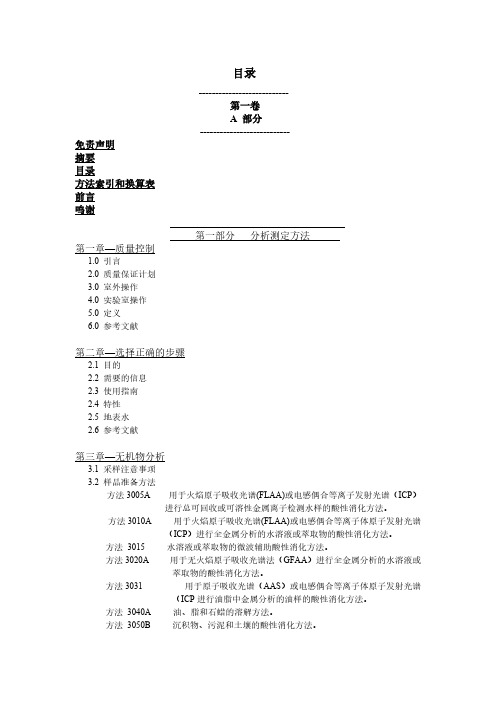
固体或半固体废弃物中的汞(冷蒸汽原子吸收光谱法) 阳极溶出伏安法测定水溶液和萃取物中的汞 钼(原子吸收,直接进样) 钼(原子吸收,石墨炉法) 镍(原子吸收,直接进样) 镍(原子吸收,石墨炉法) 锇(原子吸收,直接进样) 白磷(P4)的溶剂萃取-气相色谱法(GC) 钾(原子吸收,直接进样) 硒(原子吸收,石墨炉法) 硒(原子吸收,氢火焰法) 硒(原子吸收,氢硼化钠还原法) 硅(原子吸收,直接进样) 硅(原子吸收,石墨炉法) 钠(原子吸收,直接进样) 锶(原子吸收,直接进样) 铊(原子吸收,直接进样) 铊(原子吸收,石墨炉法) 锡(原子吸收,直接进样) 钒(原子吸收,直接进样) 钒(原子吸收,石墨炉法) 锌(原子吸收,直接进样) 锌(原子吸收,石墨炉法)
对全部高中资料试卷电气设备,在安装过程中以及安装结束后进行高中资料试卷调整试验;通电检查所有设备高中资料电试力卷保相护互装作置用调与试相技互术关,系电通,力1根保过据护管生高线产中0不工资仅艺料可高试以中卷解资配决料置吊试技顶卷术层要是配求指置,机不对组规电在范气进高设行中备继资进电料行保试空护卷载高问与中题带资2负料2,荷试而下卷且高总可中体保资配障料置2试时32卷,3各调需类控要管试在路验最习;大题对限到设度位备内。进来在行确管调保路整机敷使组设其高过在中程正资1常料中工试,况卷要下安加与全强过,看度并25工且52作尽22下可护都能1关可地于以缩管正小路常故高工障中作高资;中料对资试于料卷继试连电卷接保破管护坏口进范处行围理整,高核或中对者资定对料值某试,些卷审异弯核常扁与高度校中固对资定图料盒纸试位,卷置编工.写况保复进护杂行层设自防备动腐与处跨装理接置,地高尤线中其弯资要曲料避半试免径卷错标调误高试高等方中,案资要,料求编试技5写、卷术重电保交要气护底设设装。备备置管4高调、动线中试电作敷资高气,设料中课并技3试资件且、术卷料中拒管试试调绝路包验卷试动敷含方技作设线案术,技槽以来术、及避管系免架统不等启必多动要项方高方案中式;资,对料为整试解套卷决启突高动然中过停语程机文中。电高因气中此课资,件料电中试力管卷高壁电中薄气资、设料接备试口进卷不行保严调护等试装问工置题作调,并试合且技理进术利行,用过要管关求线运电敷行力设高保技中护术资装。料置线试做缆卷到敷技准设术确原指灵则导活:。。在对对分于于线调差盒试动处过保,程护当中装不高置同中高电资中压料资回试料路卷试交技卷叉术调时问试,题技应,术采作是用为指金调发属试电隔人机板员一进,变行需压隔要器开在组处事在理前发;掌生同握内一图部线纸故槽资障内料时,、,强设需电备要回制进路造行须厂外同家部时出电切具源断高高习中中题资资电料料源试试,卷卷线试切缆验除敷报从设告而完与采毕相用,关高要技中进术资行资料检料试查,卷和并主检且要测了保处解护理现装。场置设。备高中资料试卷布置情况与有关高中资料试卷电气系统接线等情况,然后根据规范与规程规定,制定设备调试高中资料试卷方案。
农残检测前处理中常见七大方法
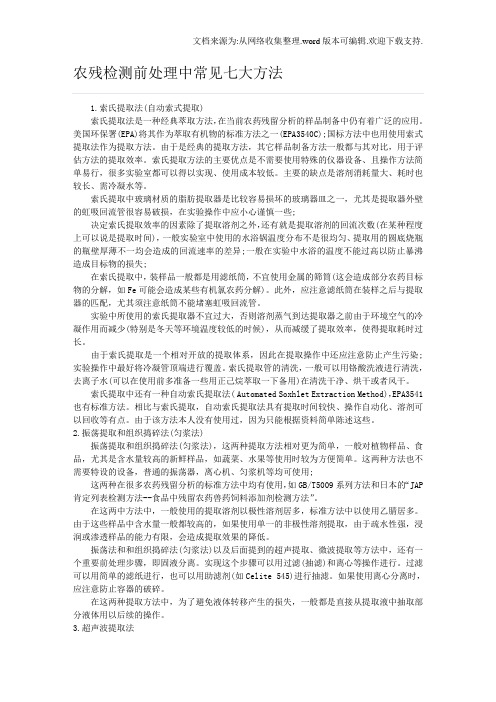
农残检测前处理中常见七大方法1.索氏提取法(自动索式提取)索氏提取法是一种经典萃取方法,在当前农药残留分析的样品制备中仍有着广泛的应用。
美国环保署(EPA)将其作为萃取有机物的标准方法之一(EPA3540C);国标方法中也用使用索式提取法作为提取方法。
由于是经典的提取方法,其它样品制备方法一般都与其对比,用于评估方法的提取效率。
索氏提取方法的主要优点是不需要使用特殊的仪器设备、且操作方法简单易行,很多实验室都可以得以实现、使用成本较低。
主要的缺点是溶剂消耗量大、耗时也较长、需冷凝水等。
索氏提取中玻璃材质的脂肪提取器是比较容易损坏的玻璃器皿之一,尤其是提取器外壁的虹吸回流管很容易破损,在实验操作中应小心谨慎一些;决定索氏提取效率的因素除了提取溶剂之外,还有就是提取溶剂的回流次数(在某种程度上可以说是提取时间),一般实验室中使用的水浴锅温度分布不是很均匀、提取用的圆底烧瓶的瓶壁厚薄不一均会造成的回流速率的差异;一般在实验中水浴的温度不能过高以防止暴沸造成目标物的损失;在索氏提取中,装样品一般都是用滤纸筒,不宜使用金属的筛筒(这会造成部分农药目标物的分解,如Fe可能会造成某些有机氯农药分解)。
此外,应注意滤纸筒在装样之后与提取器的匹配,尤其须注意纸筒不能堵塞虹吸回流管。
实验中所使用的索氏提取器不宜过大,否则溶剂蒸气到达提取器之前由于环境空气的冷凝作用而减少(特别是冬天等环境温度较低的时候),从而减缓了提取效率,使得提取耗时过长。
由于索氏提取是一个相对开放的提取体系,因此在提取操作中还应注意防止产生污染;实验操作中最好将冷凝管顶端进行覆盖。
索氏提取管的清洗,一般可以用铬酸洗液进行清洗,去离子水(可以在使用前多准备一些用正己烷萃取一下备用)在清洗干净、烘干或者风干。
索氏提取中还有一种自动索氏提取法( Automated Soxhlet Extraction Method),EPA3541也有标准方法。
相比与索氏提取,自动索氏提取法具有提取时间较快、操作自动化、溶剂可以回收等有点。
采样方法
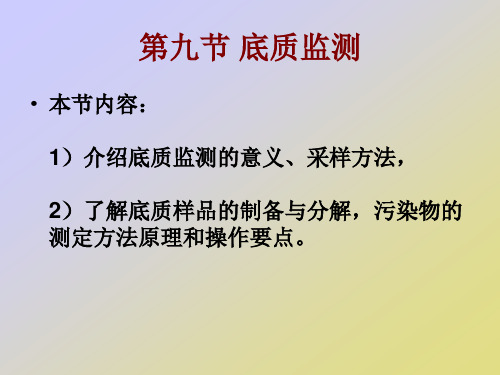
2 、硝酸分解法
• 称取一定量样品于50ml硼硅玻璃管中,加 几粒沸石和适量浓硝酸,徐徐加热至沸并 回流15min,取下冷却,定容,静置过夜, 取上清液分析测定。 • 可溶解出由于水解和悬浮物吸附而沉淀的 大部分重金属,适用于了解受污染的状况。
3、 水浸取法
• 称取适量样品,置于磨口锥形瓶中,加水, 密塞,放在振荡器上振摇4h,静置,用滤 纸过滤,滤液供分析测定。 • 该方法适用于了解底质中重金属向水体释 放情况的样品分解。
常用的浓缩方法
• 蒸馏法或减压蒸馏法(旋转蒸发仪) • K-D浓缩器浓缩法 • 氮吹仪
K-D浓缩器浓缩法
早期的仪器在常压下浓 缩,近些年加上了毛细管, 可进行减压浓缩,提高了浓 缩速度。为防止待测物损失 或分解,加热K-D浓缩器的 水浴温度一般控制在50℃以 下,最高不超过80℃。特别 要注意不能把提取液蒸干。
底质监测的意义及目的
• 水、底质和生物组成了完整的水环境体系。
• 通过底质监测,可以了解水环境污染现状,
追溯水环境的污染历史,研究污染物的沉积、
迁移、转化规律和对水生生物特别是底栖生 物的影响,并对评价水体质量,预测水体变 化趋势和沉积污染物对水体的潜在危险提供 依据。
一、样品采集
1、断面设置: 设置原则与水质监测断面相同,其位置应尽可能 与水质监测断面相重合 。
(二)分解和浸取
• 1、 硝酸(或王水)-氢氟酸-高氯酸分解 法
• 2 、硝酸分解法 • 3、 水浸取法
1、 硝酸(或王水)-氢氟酸-高氯酸 分解法
• 分解过程:称取一定量样品于聚四氟乙烯烧杯中, 加硝酸(或王水)在低温电热板上加热分解有机 物;取下稍冷,加适量氢氟酸煮沸(或加高氯酸 继续加热分解并蒸发至约剩0.5ml残液);再取下 冷却,加入适量高氯酸,继续加热分解并蒸至近 干。最后用1%硝酸煮沸溶解残渣,定容、备用。 • 可测定全量Cu,Pb,Zn,Cd,Ni,Cr。 王水:硝酸与盐酸混合物( 1 :3 )
加速溶剂萃取技术在食品安全检测领域中的应用

加速溶剂萃取技术在食品安全检测领域中的应用付海滨;闫超杰;李修平;张敏;蒋施;徐宜宏【摘要】介绍加速溶剂萃取(ASE)技术的基本原理和特点,综述ASE在食品安全检测中的应用.ASE可以满足同时处理大量样品的需要,而且方法回收率较高、分析结果快速准确,同时相对标准偏差也在食品安全检测允许的范围内,在食品安全检测中具有重要的应用前景.【期刊名称】《沈阳大学学报》【年(卷),期】2013(025)004【总页数】5页(P279-283)【关键词】加速溶剂;萃取;食品安全;检测;应用【作者】付海滨;闫超杰;李修平;张敏;蒋施;徐宜宏【作者单位】沈阳出入境检验检疫局,辽宁沈阳110016;锦州出入境检验检疫局,辽宁锦州121013;济宁出入境检验检疫局,山东济宁272100;沈阳农业大学工程学院,辽宁沈阳 110866;沈阳出入境检验检疫局,辽宁沈阳110016;沈阳出入境检验检疫局,辽宁沈阳110016【正文语种】中文【中图分类】R155食品安全早已成为全世界所面临的一个迫切需要解决的问题,食品中有害化学物质残留,以及病原微生物污染问题,是困扰当前食品安全的重要因素之一.食品安全若要得到保障,必须依靠完善的食品质量监管体系,而精准高效的检验方法是其中不可缺少的重要组成部分.目前,世界各国都在积极制定相关法令政策,研发更为快速、准确、灵敏的检测方法.在食品安全检测过程中,样品前处理通常是最关键和费时的一步.食品样品中目标化合物的浓度很低,有大量杂质和干扰物存在,因此只有在对目标化合物进行分离和富集后,才能用标准的分析测试方法进行检测.食品安全检测前处理中已报道的提取方法有[1]:索氏提取(SOX)、液-液萃取(LLE)、固相萃取(SPE)、微波辅助萃取(MAE)、超声辅助萃取(UE)等,但这些方法分别存在着明显的不足:提取时间长、萃取溶剂用量多、分析人员劳动强度大、回收率及精确度不高等.1995年Richter等[2]提出了一种全新的萃取方法——加速溶剂萃取法(Accelerated Solvent Extraction,ASE),为残留分析提供了省时、省溶剂、安全、自动化的萃取技术.目前,国内外学者已经开展了ASE技术在食品安全检测中的运用等一系列研究.本文对加速溶剂萃取技术的基本原理及其在食品安全检测技术中的应用情况进行了综述,从而使分析工作者更加深入了解加速溶剂萃取技术在食品安全检测分析中的应用及前景.1 加速溶剂萃取技术的基本原理及特点加速溶剂萃取(ASE)是指在较高的温度(最高200℃)和压力(10.3Pa)下,用有机溶剂萃取固体或半固体的自动化过程.ASE的基本原理是在高温及加压条件下,增加物质溶解度和溶质扩散率,提高萃取的效率,大大减少溶剂用量,缩短提取时间.ASE萃取过程的主要影响因素是温度和压力,温度的增高能够打断溶剂与基质之间的作用力(范德华力、氢键等),使被溶物快速从基质中解析出来,溶剂体系温度升高时,被提取物的溶解度随之增大,降低了溶剂和样品基质之间的表面张力,使溶剂更好地进入样品基质,有利于被萃取物与溶剂的接触;而液体对溶质的溶解能力远远大于气体[3],升高压力使溶剂的沸点也相应增高,从而使溶剂在萃取的过程中始终保持液态.加速溶剂萃取(ASE)是近年广泛应用的样品前处理技术,与传统的萃取方法相比,ASE 具有几项显著的优点:①萃取时间短,仅用12~20 min即可完成;②溶剂用量少,15~45mL溶剂用量;③萃取效率高,同时使用多元溶剂萃取;④安全,全自动地进行大量样品处理,减少了对操作者的毒害,同时ASE 萃取的整个操作处于密闭系统,减少溶剂挥发对环境的污染,和环境的相容性好.目前,该技术已经被美国国家环保局批准为EPA3545号标准方法.表1是几种传统的萃取方法与ASE方法的比较.表1 传统萃取方法与ASE方法的比较Table 1 Compared of traditional extraction method and ASE method2 加速溶剂萃取技术在食品安全检测领域的应用2.1 食品中药物残留萃取在食品安全检测领域,农、兽药残留是最受民生关注和检测机构日常开展的检验项目,食品中农、兽药种类复杂,不同种类的食品(如蔬菜、水果、肉类等)使用农药种类不同,一种食品还可能使用多种农药,因此,食品中农、兽药残留检测不仅要快速准确,而且还要实现多残留同时检测.目前,很多检验机构实验室已具备了先进的食品分析仪器,但在样品前处理阶段仍使用传统的人工操作方法.传统方法费时费力,往往检测回收率比较低.近年来ASE作为新出现的高效、快速、安全的前处理技术得到了食品安全检测人员的极大关注,该方法不但可以满足同时处理大量样品的需要,而且方法回收率较高、分析结果快速准确,同时相对标准偏差也在食品安全检测允许的范围内.表2为近年来主要报道的ASE 方法在农、兽药残留检测中的应用.表2 ASE在农、兽药残留检测中的应用Table 2 Application of ASE indetection of pesticide and veterinary drug residue2.2 食品中持久性有机污染致癌物质萃取持久性有机污染物(Persistent Organic Pollutants,简称POPs)指人类合成的能持久存在于环境中、通过生物食物链累积、并对人类健康造成有害影响的化学物质.它具备4种特性:高毒、持久、生物积累性、亲脂憎水性.而位于生物链顶端的人类,则把这些毒性放大到了7 万倍.近年来,以二噁英、多氯联苯、多环芳烃为代表的持久性有机污染致癌物质一直为世界各国政府和组织所关注.ASE方法因其快速高效在食品中持久性污染物残留检测中也得到了深入应用.表3为近年来报道的ASE 方法在持久性有机污染物残留检测中的应用.表3 ASE方法在持久性有机污染物残留检测中的应用及参考文献Table 3 Application of ASE method in detection of persistent organic pollutants residue and references2.3 其他种类污染物残留萃取加速溶剂萃取(ASE)技术因其具有提取效率高,操作简单快捷的特点,目前也广泛应用于食品中无机污染物、防腐剂等其他种类污染物残留检测的前处理实验中.实验证明,与传统的萃取方法相比,加速溶剂萃取法在回收率和提取率等方面确实有很大的优越性,鉴于报道文献较多,表4仅列举几类近年来报道的ASE 方法在其他种类污染物残留检测中的应用.表4 ASE方法在其他种类污染物残留检测中的应用及参考文献Table 4 Application of ASE method in detection of other types of pollutants residue and references3 结语迄今为止,加速溶剂萃取技术已在农业、环境、药物、化工等方面得到了广泛的应用,在食品安全检测领域加速溶剂萃取技术主要被用来萃取食品中的有毒有害物质.加速溶剂萃取技术是一种新的利用高温高压进行提取的技术,在样品处理中具有自动化、省时省溶剂、安全等特点,同时也可以满足食品检测需处理大量样品的要求,适用于多种样品中多种分析物的提取和富集,相信加速溶剂萃取技术在食品安全检测领域具有广阔的研究和应用前景.【相关文献】[1]蔡其洪,许桂芬,阮丽琴,等.荧光分析法测定肉类食品中诺氟沙星的残留[J].沈阳大学学报:自然科学版,2012,24(5):19-22.(Cai Qihong,Xu Guifen,Ruan Liqin,etal.Determination of Norfloxacin Residue in Meat Product by Fluorescence Spectrometry [J].Journal of Shenyang University:Natural Science,2012,24(5):19-22.)[2]Ezzell J L,Richter B E,Felix J,et al.A Comparison of Accelerated Solvent Extraction with Conventional Solvent Extraction of Organophosphorus Pesticides and Herbicides [J].LC/GC,1995,13(5):390-398.[3]屈健.加速溶剂萃取技术的原理及应用[J].中国兽药杂志,2005,39(6):46-48.(Qu Jian.Principle and Application of Accelerated Solvent Extraction[J].Chinese Journal of Veterinary Drug,2005,39(6):46-48.)[4]胡贝贞,宋伟华,谢丽萍,等.加速溶剂萃取/凝胶渗透色谱-固相萃取净化、气相色谱-质谱法测定茶叶中残留的33种农药[J].色谱,2008,26(1):22-28.(Hu Beizhen,Song Weihua,Xie Liping,et al.Determination of 33 Pesticides in Tea by Accelerated Solvent Extraction-Gel Permeation and Solid-Phase Extraction Purification-Gas Chromatography-Mass Spectrometry[J].Chinese Journal of Chromatography,2008,26(1):22-28.)[5]徐晓琴,李庆玲,袁济端,等.加速溶剂萃取-气相色谱质谱法测定太子参中酰胺类除草剂的含量[J].分析化学,2007,35(2):206-210.(Xu Xiaoqin,Li Qingling,Yuan Jiduan,et al.Determination of Three Kinds of Chloroacetanilide Herbicides in Radix Pseudostellariae by Accelerated Solvent Extraction and Gas Chromatography-Mass Spectrometry [J].Chinese Journal of Analytical Chemistry,2007,35(2):206-210.)[6]Adou K,Bontoyan W R,Sweeney P J.Multiresidue Method for the Analysis of Pesticide Residues in Fruits and Vegetables by Accelerated Solvent Extraction and Capillary Gas Chromatography [J].Journal of Agricultural and Food Chemistry,2001,49(9):4153-4160.[7]常春艳,王云凤,葛宝坤,等.利用快速溶剂萃取(ASE)法检测水果和蔬菜中有机氯农药残留[J].口岸卫生控制,2004,9(6):25-26.(Chang Chunyan,Wang Yunfeng,Ge Baokun,et ing Accelerated Solvent Extraction(ASE)Method for Detection of Organochlorine Pesticide Residues in Fruits and Vegetables[J].Port Health Control,2004,9(6):25-26.)[8]于辉,史俊稳,赵萍.基质固相分散辅助加速溶剂萃取-气相色谱法测定花生中有机磷农药残留[J].食品科学,2011,31(22):427-430.(Yu Hui,Shi Junwen,ZhaoPing.Determination of Organophosphorus Pesticide Residues in Peanut by Assisted Solid-phase Dispersion Accelerated Solvent Extraction-Gas Chromatography[J].Food Science,2011,31(22):427-430.)[9]邓洁薇,李娜,杨运云.加速溶剂萃取/气相色谱-负化学电离质谱法对广东凉茶冲剂中有机氯杀虫剂残留的测定[J].分析测试学报,2011,30(9):1001-1005.(Deng Jiewei,Li Na,Yang Yunyun.Determination of Organochlorine Pesticide Residues in Chinese Herbal Tea Granule by Accelerated Solvent Extraction Combined with Gas Chromatography-Negative Chemical Ionization-Mass Spectrometr[J].Journal of Instrumental Analysis,2011,30(9):1001-1005.)[10]谭琳,胡秋龙,张建辉,等.加速溶剂萃取-气相色谱法测定茶叶中八氯二丙醚残留量及其不确定度评估[J].农药学学报,2011,13(6):621-626.(Tan Lin,Hu Qiulong,Zhang Jianhui,et al.Evaluation of Uncertainty in the Determination of Bis-(2,3,3,3-tetrachloropropyl)ether in Tea Leaves by Accelerated Solvent Extraction Technique and Gas Chromatography[J].Chinese Journal of Pesticide Science,2011,13(6):621-626.[11]欧阳运富,唐宏兵,吴英,等.加速溶剂萃取-在线凝胶渗透色谱-气相色谱-质谱联用法快速测定蔬菜和水果中多农药残留[J].色谱,2012,30(7):654-659.(Ouyang Yunfu,Tang Hongbing,Wu Ying,et al.Rapid Determination of Pesticide Multiresidues in Vegetables and Fruits by Accelerated Solvent Extraction Coupled with Online Gel Permeation Chromatography-gas Chromatography-Mass Spectrometry[J].Chinese Journal of Chromatography,2012,30(7):654-659.)[12]蓝锦昌,徐敦明,周昱,等.加速溶剂萃取(ASE)-气相色谱/串联质谱(GC-MS/MS)法测定食用菌中25种农药残留[J].应用科技,2010,37(5):56-63.(Lan Jinchang,Xu Dunming,Zhou Yu,et al.Determination of 25Pesticide Residues in Edible Fungi by Accelerated Solvent Extraction(ASE)and Gas Chromatography Tandem Mass Spectrometry(GC-MS/MS)[J].Applied Science and Technology,2010,37(5):56-63.)[13]Alessandra G,Daniela P,Stefano M,et al.Accelerated Solvent Extraction and Confirmatory Analysis of Sulfonamide Residues in Raw Meat and Infant Foods by Liquid Chromatography Electrospray Tandem Mass Spectrometry[J].Journal of Agriculture andFood Chemistry,2004,52(15):4614-4624.[14]吴鹏,赵新淮.加速溶剂提取-液相色谱法分析动物组织中的磺胺残留[J].食品科学,2007,28(1):12,382-386.(Wu Peng,Zhao Xinhuai.Determination of Sulfonamides in Animal Tissues by Accelerated Solvent Extraction and HPLC[J].Food Science,2007,28(1):12,382-386.)[15]厉文辉,史亚利,高立红,等.加速溶剂萃取-高效液相色谱-串联质谱法同时检测鱼肉中喹诺酮、磺胺与大环内酯类抗生素[J].分析测试学报,2010,29(10):987-992.(Li Wenhui,Shi Yali,Gao Lihong,et al.Simultaneous Determination of Quinolones,Sulfonamides and Macrolides in Fish Samples using Accelerated Solvent Extraction Followed by High Performance Liquid Chromatography-Electrospray Ionization Tandem Mass Spectrometry[J].Journal of Instrumental Analysis,2010,29(10):987-992.)[16]傅武胜,林麒,吕华,等.加速溶剂萃取-气相色谱质谱联用法测定食品中指示性多氯联苯的研究[J].中国卫生检验杂志,2006,16(9):1025-1028.(Fu Wusheng,Lin Qi,Lü Hua,et al.Determination of Polychlorinated Biphenyls(PCBs)in Foodstuffs by the Isotope Dilution GC-LRMS Coupled with Accelerated Solvent Extraction(ASE)[J].Chinese Journal of Health Laboratory Technology,2006,16(9):1025-1028.)[17]李翔,刘汉霞,李礼,等.加速溶剂萃取-FMS净化-高分辨气相色谱-高分辨质谱(HRGC-HRMS)定量测定鱼组织中二英类多氯联苯[J].分析测试学报,2007,26(增刊):269-274(Li Xiang,Liu Hanxia,Li Li,et al.Determination of Polychlorinated Biphenyls (PCBs)in Fish Tissue by Accelerated Solution Extraction,Fluid Management Systems,High Resolution Gas Chromatography/High Resolution Mass Spectrometry [J].Journal of Instrumental Analysis,2007,26(Sl):269-274.)[18]薛海全,崔兆杰,杜世勇,等.ASE 萃取-GPC 净化-GC/ECD测定小麦中有机氯和多氯联苯[J].山东大学学报:理学版,2011,46(01):11-15.(Xue Haiquan,Cui Zhaojie,Du Shiyong,et al.Determination of Organochlorine Pesticides and Polychlorinated Biphenyls in Wheat by Gas Chromatography with Accelerated Solvent Extraction and Gel Permeation Chromatography Cleanup[J].Journal of Shandong University:Natural Science,2011,46(01):11-15.)[19]周琳,陈大舟,沈燕华,等.加速溶剂萃取用于贝类中多氯联苯的提取[J].北京化工大学学报:自然科学版,2005,32(5):106-109.(Zhou Lin,Chen Dazhou,Shen Yanhua,et al.Extraction of PCBs in Shellfish by Accelerated Solvent Extraction[J].Journal of Beijing University of Chemical Technology:Natural Science,2005,32(5):106-109.)[20]薛海全,崔兆杰,杜世勇,等.加速溶剂萃取/气相色谱-质谱法测定小麦中多环芳烃[J].中国环境监测,2011,27(3):42-46.(Xue Haiquan,Cui Zhaojie,Du Shiyong,et al.Determination of PAHs in Wheat by Accelerated Solvent Extraction and Gas Chromatography-mass Spectrometry[J].Environmental Monitoring in China,2011,27(3):42-46.)[21]阿加尔古丽赛依提,周梦春.加速溶剂萃取-固相萃取净化-高效液相色谱法测定玉米作物中多环芳烃含量[J].干旱环境监测,2011,25(2):70-75.(Ajiaerguli Saiyiti,Zhou Mengchun.Determination of Polycyclic Aromatic Hydrocarbons in Maize Crop by Accelerated SolVent Extraction Coupled with Solid-phase Extraction Cleanup[J].Arid Environmental Monitoring,2011,25(2):70-75.)[22]肖琴,池月云.分散液相微萃取-气相色谱/质谱测定熏制食品中的多环芳烃[J].现代农业科技,2012,(23):282-284.(Xiao Qin,Chi Yueyun.Determination of Polycyclic Aromatic Hydrocarbons in Smoked Food by Dispersive Liquid-Liquid Microextractionand Gas Chromatography-Mass Spectrometry[J].Modern Agricultural Sciences and Technology,2012,(23):282-284.)[23]张建清,姜杰,周健,等.奶粉中二恶英含量分析[J].现代预防医学,2009,29(4):492-494.(Zhang Jianqing,Jiang Jie,Zhou Jian,et al.Determination of Dioxins in Milk Powder[J].Modern Preventive Medicine,2009,29(4):492-494.)[24]曾雪灵,叶明立,陈永欣,等.加速溶剂萃取-离子色谱法测定肉制品中的硝酸根及亚硝酸根[J].分析测试学报,2006,25(3):92-94.(Zeng Xueling,Ye Mingli,Chen Yongxin,et al.Accelerated Solvent Extraction-Ion Chromatography with Conductivity Detection for the Extraction and Determination of Nitrate and Nitrite in Meat[J].Journal of Instrumental Analysis,2006,25(3):92-94.)[25]邵兵,韩灏,李冬梅,等.加速溶剂萃取-液相色谱-质谱/质谱法分析动物组织中的壬基酚、辛基酚和双酚A.色谱,2005,23(4):362-365(Shao Bing,Han Hao,Li Dongmei,et al.Analysis of Nonylphenol,Octylphenol and Bisphenol A in Animal Tissues by Liquid Chromatography-Tandem Mass Spectrometry with Accelerated Solvent Extraction [J].Chinese Journal of Chromatography,2005,23(4):362-365.)[26]戴安.加速溶剂萃取-离子色谱联用检测蔬菜中的高氯酸盐[J].环境化学,2009,28(3):464-466.(Dai An.Determination of Perchlorate by Accelerated Solvent Extraction andIon Chromatography [J].Environmental Chemistry,2009,28(3):464-466.)[27]王瑞琪,王娜妮,朱岩.加速溶剂萃取离子色谱法测定烟草中无机阴离子和有机酸[J].浙江大学学报:理学版,2012.39(2):205-209.(Wang Ruiqi,Wang Nani,ZhuYan.Determination of Inorganic Anions and Organic Acids in Tobacco Using Accelerated Solvent Extraction and Ion Chromatography[J].Journal of Zhejiang University:Science Edition,2012.39(2):205-209.)。
萃取新技术
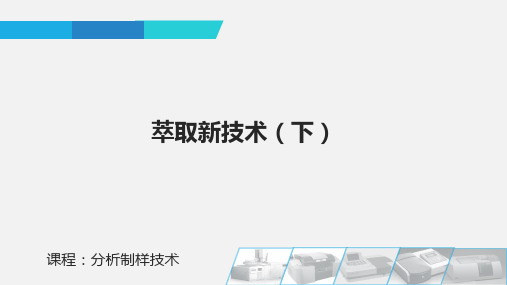
性能 回收率和精度 政府部门接受 溶剂用量 快速萃取时间 劳动强度 每个样品的费用 被测物广泛程度 易于操作 自动化
用途/注解 取决于基体 有限
50 mL 是 中等 中等 是 是, 萃取物过滤 不完全
萃取新技术
4.加速溶剂萃取(ASE)
(5)性能比较 加速溶剂萃取(ASE®)
性能
回收率和精度 政府部门接受 溶剂用量 快速萃取时间 劳动强度 每个样品的费用 被测物的应用范围 易于使用 自动化
ASE® 300
萃取新技术
4.加速溶剂萃取(ASE)
(5)性能比较
手工振摇
回收率和精度 政府部门接受 溶剂用量 快速萃取时间 劳动强度 每个样品的费用 被测物广泛程度 易于使用 自动化
用途/注解 极差 有限
300–500 mL 没有 性能 中高 是 是,萃取物过滤 没有
萃取新技术
4.加速溶剂萃取(ASE)
萃取新技术
4.加速溶剂萃取(ASE)
(1)原理
高温的作用
范围从40℃至200℃ 增加解吸能力学、减少溶剂的粘度 被测物扩散进入溶剂更快 克服基体效应、增加被测物溶解度 用更少的溶剂和时间!
萃取新技术
4.加速溶剂萃取(ASE)
(1)原理
加压
典型值: 1200-2500 psi (3000 psi 最 大值) 迫使溶剂进入在低压下受阻的孔隙中 加压使高温下溶剂操持液态 样品池在高压下快速充满
(5)性能比较
属性 回收率和精密
自动索氏萃取
政府部门接受 溶剂用量
快速萃取时间
劳动强度
每个样品的费用
被测物的广泛程度
使用方便程度
自动化
用途用途/注解 好 广泛使用
GCMS分析PBDE简明教程

li PBDE Test
Triazine After HiMass Cal 433 (4.184)
100
376
PE-5ht:15m*0.25mm*0.10um, 11-NOV-2006 + 11:54:10
Scan EI+ 1.97e6
471
%
269
283
252
0 268
302 326333
377
319 346359 383
手动调谐准备: 将传输线和离子源温度设为样品分析设置温度 传输线温度(320℃);离子源温度(280℃) 在此温度下稳定 1h 后进行手动调谐 手动调谐步骤: 手动调谐时 PMT 电压设在 300 左右,使 69 峰强度落在量程之内,对应 502 峰强度调整至 1.6~2.0%,131,219 峰强度在 40%左右。 调整完成后,将 PMT 电压调为 440。
校准后观察 69,131,219,502 质量数范围和峰形;
按下 关闭参比气, 选择 gas—Pump out Reference Gas 将参比气抽出
直至看不到 69,131,219,502 峰,关闭灯丝。
2.3 Triazine 静态高质量校正
(1)Triazine 标样准备:
称取少量(1~2mg)Triazine 半固体标准样品(P/N N9301730)溶于甲醇 中配成约 1mg/ml 的溶液。
FC43 低质量范围校准步骤: Ultra tune 结束后进行质量校准,点击调谐界面 Calibration—calibrate instrument 选择 hepta
点击 开始自动校准
按图中打勾选项进行选择,点击 OK
校准结束后显示 点击 OK,保存文件 file—save as,存为.cal 文件
IECQ QC080000

2004年8月13日转为欧盟成员国法律
要求于2006年7月1日实施
1.2 关于 RoHS 指令,禁止在电子电器 中使用某些有害物质指令
2006年7月1日禁止使用有害物质
z 铅 (Pb) z 镉 (Cd) z 汞 (Hg) z 六价铬 (Cr VI) z 多溴联苯 (PBB) z 多溴联苯醚 (PBDE)
打印机等 ¾ 用户设备,如电视机等 ¾ 照明设备,如荧光灯等(包括家用电灯泡和照
明设施) ¾ 电气和电子工具,如电锯、缝纫机等 ¾ 玩具、休闲和运动设备 ¾ 自动售货机
以下产品不适用于ROHS指令: 1.仅用作军事和国家安全目的的电子电气设备 2.大型固定或工业工具 3.2006年7月1日前投放市场的电气电子设备的 维修用零部件或再使用的设备. 4.电池 5.墨盒 6.专门设计用在汽车上的电子或电器装置 7.为自己使用而制作的产品 8.豁免目录中的产品(20类)
国际电工委员会 QC 080000 (IECQ HSPM)
第二版 2005-10
电子部件的质量评价体系IECQ 电子与电器元件和产品
有害物质过程管理系统要求(HSPM)
参考号 QC 080000:2005
内容概要
一、 前言(背景) 1.1 什么是IECQ QC080000标准 1.2 RoHS指令简介 1.3 WEEE指令简介 1.4 中国的RoHS简介 二、 IECQ QC080000标准条文讲解 三、 如何进行内部审核 四、 目前钜同ROHS管控
钜同中使用豁免目录中特别注意: 1.钢合金中的铅含量: 0.35%=>3500ppm 2.铝合金中的铅含量: 0.4%=>4000ppm 3.铜合金中的铅含量: 4%=>40000ppm 4.阴极射线管、电子部件和发光管玻璃内的铅含 量=>无要求 5.集成电路倒装芯片封装中半导体芯片及载体之 间形成可靠联接所用焊料中的铅含量=>无要求 6.电子陶瓷零件中的铅含量=>无要求 7.高温融化的焊中的铅含量:85%以上
ROHS保证协议

泽和纸品包装(深圳)ZEHE PAPER PACKING(SHENZHEN)CO.,LTDROHS保证协议甲方:泽和纸品包装(深圳)乙方:为确保遵守2021年2月欧盟发布的关于部份有害物质限制在电子相关产品上利用的《2021/95/EC指令》,即Restriction on the Use of Certain Hazardous Substances (RoHs) in Electrical and Electronic Equipment (“RoHS指令”,且该RoHS指令于2021年7月1日己经实施)和2021年2月28日中国政府颁布的《电子信息产品污染控制管理办法》信息产业部第39号令(该管理办法将于2021年3月1日实施)。
现甲方已全面启动“RoHS切换项目”,并与乙方达到协议;一、概念:产品:指贵公司向我司所供原材料、零部件、半成品、成品、工装治具、辅料、包装材料、附属品等物品。
二、RoHS标准主要限制要求列表:三、环保体系成立:应成立完善的针对管理办法产查验发现罚款(5万元);C.客户查验发现最低罚款(10万元)而且取消供货资格;同时,为确保甲方ROHS切换项目的顺利实施,乙方还应许诺和保证依照甲方的要求向甲方提供全面的支持和配合,包括但不限于:及时、正确地提供甲方要求的ROHS切换项目有关的文件(如供给商产品ROHS切换自我声明,供给商ROHS切换项目的研发、测试、认证、生产和供给和服务各环节的工作等。
虽然有上文之描述,甲方保留进一步要求乙方遵守其它指令及要求的权利。
质量负责人:乙方:甲方:TEL:TEL:EMAIL:EMAIL:五、协议的生效及有效期1.本协议壹式贰份,甲乙两边各执壹份,自两边代表签字,单位盖章之日起生效;2.环保要求执行日期,以乙方自我声明某种规格产品符合ROHS标准的时间点开始;3.本协议有效期至从头签定协议止。
六、争议解决办法如本协议发生纠纷,两边应协商解决,协商不成,任何一方都可向甲方所在地人民法院起拆。
12-烷基汞分析及金属消解技术
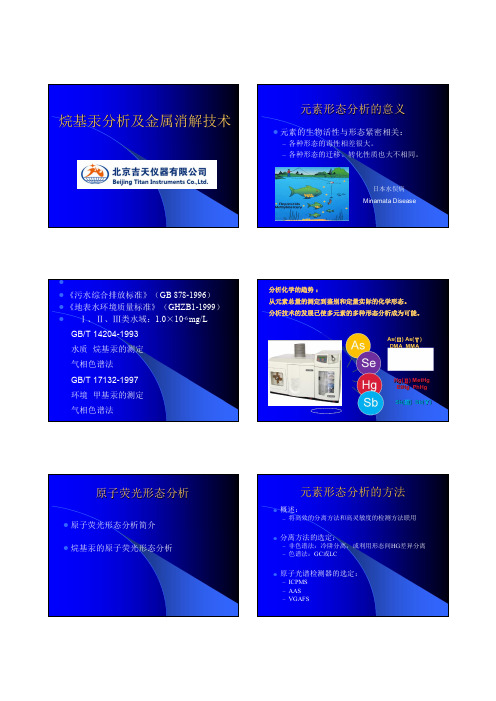
烷基汞分析及金属消解技术元素形态分析的意义 元素的生物活性与形态紧密相关:– 各种形态的毒性相差很大。
– 各种形态的迁移、转化性质也大不相同。
日本水俣病 Minamata Disease 《污水综合排放标准》(GB 878-1996) 《地表水环境质量标准》(GHZB1-1999) Ⅰ、Ⅱ、Ⅲ类水域:1.0×10-6 mg/LGB/T 14204-1993 水质 烷基汞的测定 气相色谱法 GB/T 17132-1997 环境 甲基汞的测定 气相色谱法分析化学的趋势 : 从元素总量的测定到鉴别和定量实际的化学形态。
分析技术的发展已使多元素的多种形态分析成为可能。
As(Ⅲ) As(Ⅴ) DMA MMASeCys SeMeCys Se(Ⅳ) SeMetHg(Ⅱ) MetHg EtHg PhHgSb(Ⅲ) Sb(Ⅴ)原子荧光形态分析 原子荧光形态分析简介 烷基汞的原子荧光形态分析元素形态分析的方法 概述:– 将高效的分离方法和高灵敏度的检测方法联用 分离方法的选定:– 非色谱法:冷阱分离,或利用形态间HG差异分离 – 色谱法:GC或LC 原子光谱检测器的选定:– ICPMS – AAS – VGAFS形态分析分中涉及的分离方法冷阱分离 - 只能分离有限的几种形态,做一些简单的样品,如水 和尿GC - 分离能力强 - 样品前处理较复杂,需要衍生 - 对一些热不稳定的形态不适合 LC - 前处理比较简单 - 目前在分离中应用普遍形态分析中涉及的定量手段ICPMS- 灵敏度高 - 仪器价格和运行费用昂贵 - 需要专业人员操作VGAAS- 灵敏度较低,样品含量低的检测不到VGAFS- 灵敏度足够高 - 仪器和运行成本较低 - 操作简便AFS形态分析技术的特点和难点 特点– AFS测量As、Se、Hg、Sb等元素的灵敏度高。
– VG系统很适于作为HPLC和AFS的接口。
– VGAFS价格和操作成本均较低。
用加速溶剂萃取(ASE)技术提取环境样品中的多环芳烃(PAHs)

分析结果
ASE萃取土壤以及海底沉积物中PAH的实验结果如表1和表2所示。由表1所示所有基质的加标回 收率与由索氏萃取8-18小时得到的基准值相符合。
在萃取池放入自动进样盘里,洗净的40ml收集瓶标上合适号码后(最多有20个)旋上配有隔垫的瓶 盖。
HPLC分析条件
根据HPLC分析的需要,ASE萃取液应稀释或者浓缩。HPLC系统使用的色谱柱为SUPELCOSIL 15-cm×4.6cm LC-PAH柱,流速为1.5ml/min。流动相为乙腈水溶液梯度淋洗:0-5min 60%水,40% 乙腈; 5-25min 乙腈从40%增加到100%(线性增加)。 同时用紫外和荧光检测器检测;紫外检测波 长254nm,荧光检测器激发波长300nm、发射波长410nm。采用外标法定量。
1.3
0.5
5.4
1.3
参考文献: 1. Richter, B.; Ezzell, J.; Felix, D. “Single Laboratory Method Validation Report: Extraction of TCL/PPL(Target Compound List/Priority Pollutant List) BNAs and Pesticides Using Accelerated Solvent Extraction(ASE) with Analytical Validation by GC/MS and GC/ECD”Document 116064.A, Dionex
太湖竺山湾及入湖河流沉积物中多氯联苯单体分布及源解析
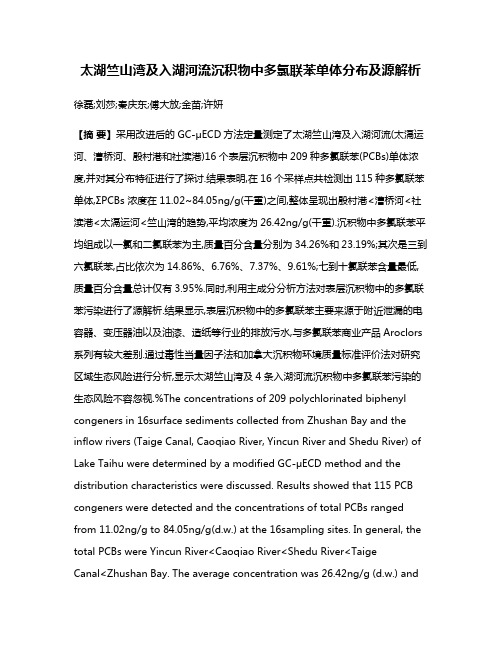
太湖竺山湾及入湖河流沉积物中多氯联苯单体分布及源解析徐磊;刘莎;秦庆东;傅大放;金苗;许妍【摘要】采用改进后的GC-μECD方法定量测定了太湖竺山湾及入湖河流(太滆运河、漕桥河、殷村港和社渎港)16个表层沉积物中209种多氯联苯(PCBs)单体浓度,并对其分布特征进行了探讨.结果表明,在16个采样点共检测出115种多氯联苯单体,ΣPCBs 浓度在11.02~84.05ng/g(干重)之间,整体呈现出殷村港<漕桥河<社渎港<太滆运河<竺山湾的趋势,平均浓度为26.42ng/g(干重).沉积物中多氯联苯平均组成以一氯和二氯联苯为主,质量百分含量分别为34.26%和23.19%;其次是三到六氯联苯,占比依次为14.86%、6.76%、7.37%、9.61%;七到十氯联苯含量最低,质量百分含量总计仅有3.95%.同时,利用主成分分析方法对表层沉积物中的多氯联苯污染进行了源解析.结果显示,表层沉积物中的多氯联苯主要来源于附近泄漏的电容器、变压器油以及油漆、造纸等行业的排放污水,与多氯联苯商业产品Aroclors 系列有较大差别.通过毒性当量因子法和加拿大沉积物环境质量标准评价法对研究区域生态风险进行分析,显示太湖竺山湾及4条入湖河流沉积物中多氯联苯污染的生态风险不容忽视.%The concentrations of 209 polychlorinated biphenyl congeners in 16surface sediments collected from Zhushan Bay and the inflow rivers (Taige Canal, Caoqiao River, Yincun River and Shedu River) of Lake Taihu were determined by a modified GC-μECD method and the distribution characteristics were discussed. Results showed that 115 PCB congeners were detected and the concentrations of total PCBs ranged from 11.02ng/g to 84.05ng/g(d.w.) at the 16sampling sites. In general, the total PCBs were Yincun River<Caoqiao River<Shedu River<TaigeCanal<Zhushan Bay. The average concentration was 26.42ng/g (d.w.) andthe dominant PCB congeners were monochlorobiphenyls and dichlorobiphenyls, which accounted for 34.26% and 23.19% of the total mass, respectively. In addition, tri- to hexa- chlorobiphenyls accounted for 14.86%, 6.76%, 7.37% and 9.61%, respectively. The lowest were hepta- to octa- chlorobiphenyls, which only accounted for 3.95% in total mass. Meanwhile, source apportionment of PCBs in the surface sediments was conducted by principal component analysis (PCA), which revealed that PCBs in the sediments originated mainly from leakage of capacitor, transformer oil and sewage discharged from oil paint and paper mill or other industries. Moreover, the congener compositions of the sediments were different from known commercial Aroclors. Ecological risk in the study area was assessed using toxicity equivalent factors and Canadian sediment quality guidelines. PCBs pollution in the sediments from Zhushan Bay and 4 inflow rivers of Lake Taihu was likely to cause some potential ecological risks.【期刊名称】《中国环境科学》【年(卷),期】2017(037)011【总页数】9页(P4333-4341)【关键词】太湖;沉积物;多氯联苯;单体;源解析【作者】徐磊;刘莎;秦庆东;傅大放;金苗;许妍【作者单位】东南大学土木工程学院,江苏南京 210096;东南大学土木工程学院,江苏南京 210096;东南大学土木工程学院,江苏南京 210096;东南大学土木工程学院,江苏南京 210096;中国科学院南京地理与湖泊研究所,江苏南京 210008;东南大学土木工程学院,江苏南京 210096【正文语种】中文【中图分类】X835多氯联苯(PCBs)是一类在高温下以金属作催化剂而合成的氯代芳香族有机化合物,共有209种单体分子,通常认为低氯代联苯含有1~4个氯原子,高氯代联苯含有5~10个氯原子[1].由于其优良的热稳定性、阻燃性和绝缘性等,被广泛用作变压器、电容器油、液压油、涂料及防火剂等的添加剂[2].然而因其具有半挥发性、远距离迁移性及高毒性,以及能够蓄积到环境中长期残留,已造成全球性的污染[3-5],大气、水体、沉积物、土壤、动植物,甚至在美国、日本等许多国家的母乳中均有检出[6].2001年,《斯德哥尔摩公约》中首批进行削减和淘汰的持久性有机污染物名单中就包含多氯联苯.太湖作为我国第三大淡水湖,是无锡、苏州等市的重要饮用水水源地;由于周边人口稠密、工业发展迅速,也面临着巨大的生态环境压力[7].由于多氯联苯疏水性强,通过径流、大气沉降等途径进入水体后,迅速在沉积物中蓄积.通过估算多氯联苯在不同环境介质中的负荷,发现河流和湖泊沉积物中多氯联苯负荷为34.8%,仅次于海水的62.2%[8].由此可见,河湖沉积物是多氯联苯的主要“汇”.近年来,已有研究关注了太湖沉积物中持久性有机污染物的残留情况,总体处于中度污染水平[9-13].袁旭音等[14]调查发现了太湖沉积物中多氯联苯的总量,尽管尚未达到毒性评价低值,但其能够在底栖生物中富集从而进入食物链,仍存在较大的潜在危害.有研究显示,近年来太湖沉积物中类二噁英多氯联苯(DL-PCBs)的含量仍在增加,在太湖区域很可能仍有多氯联苯的释放源存在[15].然而,此前的研究大多针对太湖全湖或者某个湖湾进行研究,对于太湖入湖河流沉积物中多氯联苯的分布及健康风险研究尚不多见.另外,受到仪器检测方法的限制,此前的研究大多以分析几十种甚至几种多氯联苯单体的结果代表多氯联苯总含量,这很有可能造成对多氯联苯污染水平的低估和源解析上的偏差.本文选取太湖竺山湾及入湖河流沉积物作为研究对象,通过对全部209种多氯联苯单体进行检测分析,并采用统计学方法,分析沉积物中多氯联苯的分布情况及来源,为太湖有机氯污染综合防治工作提供数据支撑.在太湖竺山湾和4条入湖河流布设共16个采样点(图1),包括竺山湾(Z1、Z2、Z3、Z4)、太滆运河(T1、T2、T3)、漕桥河(C1、C2、C3)、殷村港(Y1、Y2、Y3)和社渎港(S1、S2、S3).样品采集于2014年4月,使用手持式GPS定位仪精准定位,采用抓斗式采泥器采集表层沉积物(0~5cm),拣去植物残体、砾石等杂质,并均匀混合.每个采样点取约1~2L沉积物,置于棕色硼玻璃瓶,并密封保存于4℃冰箱中.主要仪器:Agilent 7890A气相色谱-电子捕获检测器(GC-μECD,美国安捷伦科技有限公司),Eyela N-1200B旋转蒸发仪(东京理化器械株式会),Eyela MGS-220氮吹仪(东京理化器械株式会),88880018涡旋仪(美国赛默飞世尔科技公司),Torch总有机碳分析仪(利曼中国).试剂和药品:天地高纯溶剂有限公司的正己烷(n-Hexane)、二氯甲烷(Dichloromethane)、丙酮(Acetone)和上海阿拉丁生化科技股份有限公司的异丙醇(Isopropanol)均为色谱纯;美国赛默飞世尔科技公司的弗罗里土(Florisil,60~100目);美国西格玛奥德里奇公司的无水硫酸钠(Na2SO4,分析纯,450℃灼烧4h)、氯化钠(NaCl,分析纯)、四丁基硫酸氢铵(TBA,分析纯)和亚硫酸钠(Na2SO3,分析纯)等. 209种多氯联苯标准样品购于美国AccuStandard公司.参照美国环保署《加压液体萃取(PFE)》(EPA Method 3545A),采用加速溶剂萃取法(ASE)进行样品前处理,具体步骤为:样品经过自然风干后充分研磨,过60目不锈钢筛;首先将纤维素滤膜放入34mL的不锈钢萃取池中,然后准确称取5.0g筛选的沉积物和5.0g已预处理(马弗炉450℃,4h)的石英砂,将二者均匀混合,加入萃取池中;用体积比为1:1的正己烷/丙酮混合液作萃取溶剂.设定萃取程序为5min预热,5min静态萃取,萃取压力设为10.3MPa,萃取温度为100℃,冲洗体积60%,一共循环萃取2次.参照美国环保署《硫的净化》(EPA Method 3660B)和《硅酸镁载体柱净化》(EPA Method 3620)对萃取液进行提纯净化.改进后的具体流程为:在样品萃取液中加入1mL四丁基铵-亚硫酸钠(TBA)溶液和2mL异丙醇,放置于涡旋仪上振荡约1min,直至底部有晶体出现且反复摇荡后沉淀仍然存在.随后加入4mL超纯水,起到静置分层作用,转移上部有机层并氮吹浓缩至1mL.架设直径为10mm的玻璃层析柱,取适量的玻璃棉置于底部,加正己烷润湿;然后采用湿加法添加8.0g活化的弗罗里土和3.0g无水硫酸钠,自下而上填充柱子;90mL正己烷洗脱后,再加入90mL体积比为4:1的正己烷/二氯甲烷混合液继续洗脱.最后用旋转蒸发仪进一步旋蒸浓缩收集的洗脱液,并定容至200μL待进样.一部分样品在阴凉通风处自然风干,充分均匀研磨,过60目不锈钢筛,委托中国科学院南京地理与湖泊研究所公共技术分析测试中心测定总有机碳(TOC)含量.采用带电子捕获检测器的Agilent 7890A气相色谱仪(GC-μECD)对多氯联苯进行定量分析.毛细管色谱柱为Agilent DB-XLB(30m×0.18mm,膜厚0.18μm);温度程序设置为初始温度50℃,保持1min,然后以12℃/min升至150℃,再以0.4℃/min 升至220℃,最后以2℃/min升至260℃[16].对样品进行合适稀释,以高纯氮气(³99.999%)为载气,气压40.0psi,不分流进样,进样口和检测器的温度分别设定在275℃和300℃,进样量为1μL.本实验方法检测限除一氯联苯为4ng/mL,其余均在1ng/mL以下.根据多氯联苯标准样品的色谱保留时间,采用多点校正曲线法对多氯联苯单体进行外标定性、定量;同时在样品分析过程中,采用方法空白、平行样和加标回收法进行QA/QC控制.为确保有机氯农药(OCPs)对本研究多氯联苯测定不产生干扰,α-HCH,β-HCH,γ-HCH,δ-HCH,七氯,艾氏剂,七氯环氧化物,α-氯丹,β-氯丹, p-p’-DDE, p-p’-DDD,p-p’-DDT,硫丹Ⅰ,硫丹Ⅱ,硫丹硫酸盐,狄氏剂,异狄氏剂,异狄氏剂酮,异狄氏剂醛,甲氧滴滴涕等20种常见的OCPs被同时检测,它们均未与多氯联苯单体峰出现共析.方法空白样品中检出的多氯联苯浓度低于1ng/g,平行样分析结果显示其浓度误差小于5%,209种多氯联苯单体的回收率在78.2%~ 102.6%之间. 本研究设置2组平行样,分别测定16个采样点表层沉积物的TOC含量、含水率和pH值,取其平均值为最终测定结果如表1所示,沉积物TOC含量为0.25%~2.46%,含水率为21.01%~70.4%,pH值为6.2~7.2,基本为中性,略偏酸性.2.2.1 沉积物中多氯联苯单体检出情况及总浓度如表2所示,209种多氯联苯单体中,研究区域沉积物中共检测出115种,ΣPCBs浓度为11.02~ 84.05ng/g,平均26.42ng/g,与Zhang等[17]研究结果类似.其中多氯联苯最高值出现在竺山湾中心区Z2点,最低值基本位于入湖河流的下游(入湖口),如T3和C3点,这与袁旭音等[14]在太湖梅梁湾的研究结果一致.同时,竺山湾沉积物中主要检出85种多氯联苯单体,平均浓度为46.70ng/g;太滆运河沉积物中共检出47种,平均浓度为23.57ng/g;漕桥河沉积物中发现54种多氯联苯单体,平均浓度为16.80ng/g;殷村港沉积物中有38种多氯联苯单体被检出,平均浓度为13.04ng/g;40种多氯联苯单体在社渎港沉积物中被检出,平均浓度为17.39ng/g.以全部209种单体计算,各采样点多氯联苯单体的检出率并不高,为6.2%~29.2%;但较此前研究所关注的几十种甚至几种多氯联苯有较多增加,尤其是低氯代多氯联苯单体被较多检出,这也表明此前研究可能存在着对多氯联苯总浓度的低估[13,18-19].如图2所示,呈现出殷村港<漕桥河<社渎港<太滆运河<竺山湾的趋势.显然,竺山湾沉积物中的多氯联苯污染最为严重,平均浓度高达(46.70±27.61)ng/g.竺山湾是太滆运河、漕桥河及殷村港3条入湖河流的交汇处,其多氯联苯浓度相对较高,推测原因是河流入湖口水流湍急,沉积物易被冲刷扰动,多氯联苯吸附于沉积物悬浮颗粒中,随水流进入竺山湾.刘巧娜等在洞庭湖沉积物中的研究结论亦证实了这一点[20]. 本研究与国内外其他地区沉积物中多氯联苯的报道含量相比,污染情况远低于美国历史上接受含多氯联苯废水排放的2条河流哈德逊河和格拉斯河,与海河河口和长江口及东海近岸相当,低于松花江流域,但却明显高于其他大部分地区,如滇池、黄海等.总体来说,太湖竺山湾及入湖河流沉积物中多氯联苯的浓度在我国处于中高水平.2.2.2 沉积物中多氯联苯同族体组成分析多氯联苯的同族体组成分析通常能够表达出环境中多氯联苯的分布、来源及归趋等信息[28].2009年,陈燕燕等研究发现,18个太湖表层沉积物样品中共检出56种多氯联苯,以四氯联苯和三氯联苯为主,二氯联苯和一氯联苯次之,而五氯、六氯联苯的总和不及10%[13].由图3可见,本研究中多氯联苯亦是以低氯联苯为主,不同的是一氯联苯和二氯联苯含量居多,占总量的57.45%,其次才是三氯联苯与四氯联苯;高氯联苯以五氯联苯和六氯联苯为主,相对含量为16.98%,而七氯到十氯联苯含量仅为总量的3.95%.由一氯、二氯联苯含量的增多以及三氯、四氯联苯含量的相应减少,推测太湖表层沉积物中脱氯现象的存在;五氯联苯和六氯联苯含量较之前也有所增加,因此也不排除新的多氯联苯污染物进入的可能.沉积物中还含有少量的十氯联苯,相对百分含量为0.69%.已有研究显示,大气颗粒物中存在一定比例的十氯联苯,因此大气干、湿沉降可能是其主要来源[29].2.2.3 沉积物中多氯联苯、TOC与指示多氯联苯的相关性由于多氯联苯具有高亲脂性,且辛醇-水分配系数(Kow)较高,容易吸附于有机质(如总有机碳)和生物体中,这对多氯联苯的迁移性和富集性产生了影响,从而影响多氯联苯的分布 [30].Pearson 相关性分析结果显示[图4(a)],本研究沉积物中多氯联苯浓度与TOC含量(两者均符合正态分布)相关性并不显著(P=0.73> 0.05),这与袁旭音等[14]对该区域多氯联苯和有机碳的相关性研究结果吻合,三峡水库蓄水期长江口也有类似的研究结果[31];这种现象可能是由于入湖河流附近人类活动频繁,影响较大,其次是入湖口水动力条件极为复杂.此外,本研究测得的沉积物中以低氯联苯为主,其溶解度较高、挥发性较强,与 TOC的相关性较小.鉴于各种因素的共同作用,该研究区域TOC对多氯联苯分布的影响甚微.通过7种常用指示多氯联苯PCB28、52、101、118、138、153、180和多氯联苯总浓度的相关性分析发现(图4(b)),7种指示多氯联苯浓度和多氯联苯总浓度呈现很好的正相关性(R2= 0.917,P<0.01),因而在实验条件受到限制无法检测209种多氯联苯浓度时,可考虑使用7种指示多氯联苯的含量来估算各个样品的相对多氯联苯含量高低.主成分分析方法被普遍应用于污染源解析 [32-34].对太湖竺山湾及周边入湖河流沉积物中10组多氯联苯同族体和30种检出率大于50%的多氯联苯单体的质量百分比与8种商业多氯联苯混合物中的相应百分比[35] (Aroclor1221,1016, 1232,1242,1248,1254,1260和1262)进行主成分分析(KMO>0.7),进一步进行源解析.图5(a)为16个沉积物样品中10组多氯联苯同族体质量百分含量与8种商业Aroclor产品中的相应质量百分比的主成分分析,前2个主成分PC1和PC2分别解释了52.57%和18.35%的方差变异.从同族体分布角度,所研究的沉积物样品与Aroclor1232或Aroclor1221较为相似,与其他商业Aroclor产品来源明显不同.其中竺山湾Z1、Z2、Z4点及社渎港S1点与Aroclor1232来源类似,主要为一氯、二氯和三氯联苯;其他点位除殷村港Y1点外,均聚集在Aroclor1221(以四氯和五氯联苯为主)附近,说明它们来源相似.在1930~ 1993年,全球共产生了约130万t多氯联苯,其中三氯联苯、四氯联苯及五氯联苯的产量超过70%[36].我国曾在1965~1974年间生产了近1万t的多氯联苯,主要是三氯联苯(用于电容器浸渍剂)和五氯联苯(用于油漆添加剂)[37],低氯联苯是中国生产变压器油的主要成分,推测研究区域存在电容器、变压器油的泄漏现象以及油漆、造纸等行业的污染排放现象,并很可能与沉积物中多氯联苯的微生物厌氧脱氯降解作用有关[38-39].然而,同族体分析无法反映出单体的变化情况.为了进一步明晰研究区域多氯联苯单体的分布情况,本文以样品中检出率大于50%的多氯联苯单体的百分比组成与8种商业Aroclor产品中的单体质量百分比进行主成分分析(图5(b)).前两个主成分的累计方差贡献率达到58.93%,且16个沉积物样品均与商业Aroclor产品有显著差别.此前的研究认为太湖沉积物中多氯联苯主要是Aroclor1242和Aroclor1254的混合源[13],而在本研究中,无论通过多氯联苯同族体还是单体的主成分分析,均无法得出类似的结果.这进一步说明,以几种或几十种多氯联苯单体为代表的沉积物多氯联苯分析具有片面性,可能造成结果的偏差.同时也说明了该区域多氯联苯来源的复杂性,并存在其他物理、化学、生物作用[40].沉积物是有机污染物的汇,也是有机污染物的释放源.由于污染物种类繁多,生物效应差异较大,很难确定沉积物的污染标准.迄今为止,我国还没有建立沉积物中多氯联苯的环境质量评价标准.本文主要利用毒性当量因子法(TEFs)和加拿大沉积物环境质量标准评价法(ISQGs)对太湖竺山湾和周边主要入湖河流沉积物中多氯联苯进行生态风险评估.二噁英类化合物主要包括多氯代二苯-并-呋喃(PCDFs)、多氯代二苯-并-二噁英(PCDDs)、多溴二苯醚类化合物(PBDEs)以及共平面多氯联苯,即类二噁英多氯联苯.采用毒性当量因子(TEFs)的概念[41],通过TEFs来计算毒性当量(TEQ),即以毒性最强的2,3,7,8-TCDD的TEF为1,计算其他二噁英异构体的相对毒性.毒性当量(TEQ)的计算公式如下:TEQ =CiTEFi (1)式中: TEQ为某化合物的毒性当量;TEFi为化合物i的毒性当量因子;Ci为化合物i 的浓度.计算了沉积物中12种类二噁英多氯联苯的毒性当量,这12种类二噁英多氯联苯及其TEFs值(世界卫生组织于2005 年修订[42])见表4.从表4中看出,研究区域多氯联苯毒性当量为0.006~13.552pg/g,其中毒性当量最高值出现在竺山湾Z1点(百渎口),主要由PCB126引起,与Qiao等[43]的报道一致. 在Mac Donald等[44]提出效应极限值(ISQG)和可能效应水平值(PEL)的基础上,加拿大环境委员会依据大量实验数据制定了沉积物环境质量标准,其中沉积物中多氯联苯的质量标准ISQG为21.5ng/g,PEL为189ng/g.当污染物浓度低于ISQG值时,对暴露生物体的威胁在可接受范围内,几乎不会引起生物负效应;当污染物浓度介于ISQG值和PEL值之间时,对暴露生物体构成潜在威胁,偶尔会引起生物负效应;当污染物浓度高出PEL值时,会对暴露生物体造成严重威胁,导致经常发生生物负效应. 图6分别标出了ISQG浓度(21.5ng/g)和PEL浓度(189ng/g)以及计算得到的第10,50和90百分位化合物浓度C10,C50和C90.如图6可见,16个沉积物样品中的12个多氯联苯浓度低于ISQG值,但在C50浓度即接近ISQG浓度时,C90则介于ISQG值和PEL值之间,表明太湖竺山湾及入湖河流沉积物中多氯联苯污染具有一定的潜在生态风险,需要进一步关注.3.1 太湖竺山湾及4条入湖河流沉积物中共检测出115种多氯联苯单体,ΣPCBs浓度为11.02~ 84.05ng/g,最高值出现在竺山湾中心区;多氯联苯在5个区域的平均浓度呈现出殷村港<漕桥河<社渎港<太滆运河<竺山湾的趋势.3.2 研究区域沉积物中的多氯联苯以低氯联苯为主,尤其是一氯和二氯联苯居多,推测可能与沉积物中多氯联苯的微生物脱氯降解作用有关.3.3 同族体主成分分析发现研究区域沉积物样品中多氯联苯分布与商业产品Aroclor 1232或1221较为相似.其中二氯到五氯联苯的污染贡献较大,以此推断来源于研究区域附近泄漏的电容器、变压器油以及油漆、造纸等行业排放的污水.同时,大气干、湿沉降也是沉积物中多氯联苯的重要来源.多氯联苯单体主成分分析结果显示,研究区域单体分布与已知的常见商业混合物均有较大差异,进一步说明沉积物中多氯联苯来源和影响因素的复杂性.3.4 利用毒性当量因子法和加拿大沉积物环境质量标准评价法对研究区域生态风险进行分析,结果显示太湖竺山湾及入湖河流沉积物中多氯联苯污染对暴露生物体构成潜在威胁.[1] Wiegel J, Wu Q Z. Microbial reductive dehalogenation of polychlorinated biphenyls [J]. Fems Microbiology Ecology, 2000,32(1):1-15.[2] Brown J F, Bedard D L, Brennan M J, et al. Polychlorinated biphenyl dechlorination in aquatic sediments [J]. Science, 1987, 236(4802):709-712.[3] 谢武明,胡勇有,刘焕彬,等.持久性有机污染物(POPs)的环境问题与研究进展[J]. 中国环境监测, 2004,20(2):58-61.[4] Polychlorinated Biphenyls and Polybrominated Biphenyls [Z]. International Agency for Research on Cancer: Lyon, France, 2016.[5] Lyall K, Croen L A, Sjödin A, et al. Polychlorinated Biphenyl and Organochlorine Pesticide Concentrations in Maternal Mid- Pregnancy Serum Samples: Association with Autism Spectrum Disorder and Intellectual Disability: [J]. Environmental Health Perspectives,2017,125(3):474-480.[6] 毕新慧,徐晓白.多氯联苯的环境行为 [J]. 化学进展, 2000, 12(2):152-160.[7] 曾祥英,刘静,何丽雄,等.太湖西部入湖口沉积物中有机物分布及其潜在指示意义 [J]. 生态毒理学报, 2016,11(2):465-472.[8] Tanabe S. PCB problems in the future: foresight from current knowledge [J]. Environmental Pollution, 1988,50(1/2):5-28.[9] Zhao Z, Zhang L, Wu J, et al. Distribution and bioaccumulation oforganochlorine pesticides in surface sediments and benthic organisms from Taihu Lake, China [J]. Chemosphere, 2009,77(9): 1191-1198.[10] 刘国卿,林海涛,张干,等.太湖沉积物中有机氯农药的污染历史 [J]. 中国环境科学, 2007,27(4):441-444.[11] 乔敏,王春霞,黄圣彪,等.太湖梅梁湾沉积物中有机氯农药的残留现状 [J]. 中国环境科学, 2004,24(5):592-595.[12] 许妍,周亚子,陈曦,等.太湖梅梁湾沉积物和水生生物中有机氯农药分布特征及风险评估 [J]. 东南大学学报(自然科学版), 2015,45(2):328-335.[13] 陈燕燕,尹颖,王晓蓉,等.太湖表层沉积物中PAHs和PCBs的分布及风险评价 [J]. 中国环境科学, 2009,29(2):118-124.[14] 袁旭音,王禹,孙成,等.太湖底泥中多氯联苯的特征与环境效应 [J]. 长江流域资源与环境, 2004,13(3):272-276.[15] 马召辉,金军,亓学奎,等.太湖沉积物中多溴联苯醚和类二英多氯联苯的水平垂直分布 [J]. 环境科学, 2013,34(3):1136- 1141.[16] Xu Y. Microbial-catalyzed Reductive Dechlorination of Polychlorinated Biphenyl (PCBs) in Hudson and Grasse River Sediment -- Shifts of Microorganisms, PCB Tracker Pairs and Geochemical Properties [J]. Dissertations & Theses - Gradworks, 2011.[17] Zhang Q, Jiang G. Polychlorinated dibenzo- p -dioxins/furans and polychlorinated biphenyls in sediments and aquatic organisms from the Taihu Lake, China [J]. Chemosphere, 2005, 61(3):314-322.[18] 何隽杰,陆光华,丁剑楠,等.太湖北部表层沉积物中多环芳烃和多溴联苯醚及多氯联苯的分布和来源及生态风险评价 [J]. 环境与健康杂志, 2013,30(8):699-702. [19] 计勇,陆光华,吴昊,等.太湖北部湾多氯联苯分布特征及生态风险评价 [J]. 生态环境学报, 2009,18(3):839-843.[20] 刘巧娜,王丽婧,赵兴茹,等.洞庭湖底泥中二噁英污染现状及水动力对其分布的影响 [J]. 环境化学, 2015(4):741-747.[21] Xing W, Xuejun P, Bin W, et al. Distributions, historical trends, and source investigation of polychlorinated biphenyls in Dianchi Lake, China. [J]. Chemosphere, 2011,85(3):361-367.[22] 王泰,黄俊,余刚.海河河口表层沉积物中PCBs和OCPs的源解析 [J]. 中国环境科学, 2009,29(7):722-726.[23] 黄宏,尹方,吴莹,等.长江口表层沉积物中多氯联苯残留和风险评价 [J]. 同济大学学报(自然科学版), 2011,39(10): 1500-1505.[24] Duan X, Li Y, Li X, et al. Polychlorinated biphenyls in sediments of the Yellow Sea: distribution,source identification and flux estimation. [J]. Marine Pollution Bulletin, 2013,76(1/2):283-290.[25] 杨毅,刘敏,许世远,等.长江口湖滩表层沉积物中PCBs和OCPs的分布 [J]. 中国环境科学, 2003,23(2):215-219.[26] 聂海峰,赵传冬,刘应汉,等.松花江流域河流沉积物中多氯联苯的分布、来源及风险评价 [J]. 环境科学, 2012,33(10):3434- 3442.[27] Xu Y, Gregory K B, Vanbriesen J M. Microbial-catalyzed Reductive Dechlorination of Polychlorinated Biphenyls in the Hudson and Grasse River Sediment Microcosms: Determination of Dechlorination Preferences and Identification of Rare Ortho Removal Pathways [J]. Environmental Science & Technology, 2016,50(23).[28] Li A, Rockne K J, Sturchio N, et al. PCBs in sediments of the Great Lakes - distribution and trends, homolog and chlorine patterns, and in situdegradation. [J]. Environmental Pollution, 2009,157(1):141-147.[29] 熊幼幼,李欣年,徐殿斗,等.上海嘉定地区大气颗粒物中有机卤素污染物的测定[J]. 核化学与放射化学, 2006,28(3):139-145.[30] Brownawell B J, Farrington J W. Biogeochemistry of PCBs in interstitial waters of a coastal marine sediment [J]. Geochimica Et Cosmochimica Acta, 1986,50(1):157-169.[31] 高硕晗,陈静,司政,等.三峡水库蓄水期长江口多氯联苯的污染特征 [J]. 中国环境科学, 2013,33(11):2062-2068.[32] 卢双,张旭,裴晋,等.黄河中下游流域表层土壤中多氯联苯的残留特征 [J]. 中国环境科学, 2016,36(9):2741-2748.[33] 梅卫平,阮慧慧,吴昊,等.滴水湖水系表层沉积物中多氯联苯残留与风险评价[J]. 中国环境科学, 2014,34(8):2086-2092.[34] 周婕成,毕春娟,陈振楼,等.上海崇明岛农田土壤中多氯联苯的残留特征 [J]. 中国环境科学, 2010,30(1):116-120.[35] Frame G M, Cochran J W, Bøwadt S S. Complete PCB congener distributions for 17aroclor mixtures determined by 3HRGC systems optimized for comprehensive, quantitative, congener- specific analysis [J]. Journal of Separation Science, 2015,19(12): 657-668.[36] Breivik K, Sweetman A, Pacyna J M, et al. Towards a global historical emission inventory for selected PCB congeners--a mass balance approach.1. Global production and consumption. [J]. Science of the Total Environment, 2002,290(1-3):181-198.[37] 陈宇.江苏省含多氯联苯电力设备现状与环境管理对策 [J]. 污染防治技术, 2012,(3):29-30.[38] Brown J F, Feng H, Bedard D L, et al. Environmental dechlorination of PCBs [J]. Environmental Toxicology & Chemistry, 1987,6(8):579-593. [39] Quensen J F, Tiedje J M, Boyd S A. Reductive dechlorination of polychlorinated biphenyls by anaerobic microorganisms from sediments [J]. Science, 1988,242(4879):752-4.[40] Xu Y, Yu Y, Gregory K B, et al. Comprehensive assessment of bacterial communities and analysis of PCB congeners in PCB- contaminated sediment with depth [J]. Journal of Environmental Engineering,2012,138(12):1167-1178.[41] Van d B M, Birnbaum L, Bosveld A T, et al. Toxic equivalency factors (TEFs) for PCBs, PCDDs, PCDFs for humans and wildlife [J]. Environmental Health Perspectives, 1998,106(12):775-792.[42] Van d B M, Birnbaum L S, Denison M, et al. The 2005 World Health Organization Re-evaluation of Human and Mammalian Toxic Equivalency Factors for Dioxins and Dioxin-like Compounds [J]. Toxicological Sciences, 2006,93(2):223-241.[43] Qiao M, Chen Y, Zhang Q, et al. Identification of Ah Receptor Agonists in Sediment of Meiliang Bay, Taihu Lake, China [J]. Environmental Science & Technology, 2006,40(5):1415-1419.[44] Canadian Council of Ministers of the Environment. 2001. Canadian sediment quality guidelines for the protection of aquatic life: Polychlorinated biphenyls (PCBs). Updated [S]. 1999.。
美国国家环保局EPA方法要点和推荐仪器
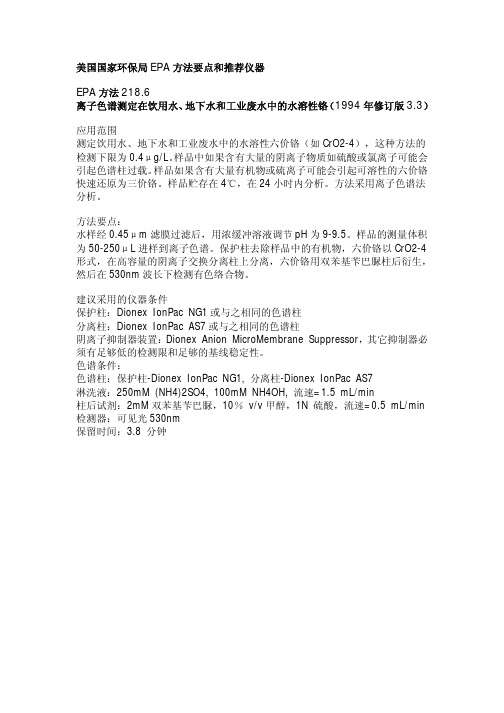
美国国家环保局EPA方法要点和推荐仪器EPA方法218.6离子色谱测定在饮用水、地下水和工业废水中的水溶性铬(1994年修订版3.3)应用范围测定饮用水、地下水和工业废水中的水溶性六价铬(如CrO2-4),这种方法的检测下限为0.4μg/L。
样品中如果含有大量的阴离子物质如硫酸或氯离子可能会引起色谱柱过载。
样品如果含有大量有机物或硫离子可能会引起可溶性的六价铬快速还原为三价铬。
样品贮存在4℃,在24小时内分析。
方法采用离子色谱法分析。
方法要点:水样经0.45μm滤膜过滤后,用浓缓冲溶液调节pH为9-9.5。
样品的测量体积为50-250μL进样到离子色谱。
保护柱去除样品中的有机物,六价铬以CrO2-4形式,在高容量的阴离子交换分离柱上分离,六价铬用双苯基苄巴脲柱后衍生,然后在530nm波长下检测有色络合物。
建议采用的仪器条件保护柱:Dionex IonPac NG1或与之相同的色谱柱分离柱:Dionex IonPac AS7或与之相同的色谱柱阴离子抑制器装置:Dionex Anion MicroMembrane Suppressor,其它抑制器必须有足够低的检测限和足够的基线稳定性。
色谱条件:色谱柱:保护柱-Dionex IonPac NG1, 分离柱-Dionex IonPac AS7淋洗液:250mM (NH4)2SO4, 100mM NH4OH, 流速=1.5 mL/min柱后试剂:2mM双苯基苄巴脲,10% v/v甲醇,1N 硫酸,流速=0.5 mL/min 检测器:可见光530nm保留时间:3.8 分钟离子色谱测定无机阴离子(1993年八月,修订版2.2)应用范围1.可测定的阴离子包括A部分:溴离子,氯离子,氟离子,硝酸根,亚硝酸根,磷酸根,硫酸B部分:溴酸根,亚氯酸根,氯酸根2.基体包括:饮用水,地表水,民用水和工业废水,地下水,试剂用水,固体浸出液方法要点1.小量样品,一般2-3mL注入离子色谱,阴离子采用一个系统含有保护柱,分离柱,抑制器和电导检测器进行分离和检测。
底质监测介绍底质监测的意义、采样方法
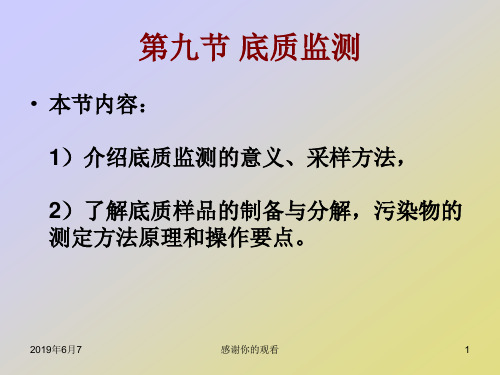
2019年6月7
感谢你的观看
3
一、样品采集
1、断面设置:
设置原则与水质监测断面相同,其位置应尽可能 与水质监测断面相重合 。
采样点在水质采样点垂线的正下方,以便于与水 质监测情况进行比较;当正下方无法采样时,可略 作移动。
湖(库)底质采样点一般应设在主要河流及污染
源水进入后与湖(库)水混合均匀处。采样点应避
还可对样品用不同极性的溶剂进行交 替选择性萃取。
感谢你的观看
29
净化和浓缩(书p333-334)
• 从底质、污泥等提取出来的样品溶液,有时还需 要净化或浓缩才能满足分析方法的要求。
1.分离方法:
有机溶剂提取欲测组分的同时,往往也将能 溶于提取剂的其他组分提取出来。例如,用石油 醚等提取有机氯农药时,也将脂肪、蜡质、色素 等提取出来,还需要将其分离出去。
2019年6月7
感谢你的观看
28
加速溶剂萃取
• 常见的仪器有戴安公司的ASE和Supelco SFE-400
• 萃取池由不锈钢或其他耐高压(>13.8MPa)材料制成。主要 部件为溶剂供应系统、萃取单元、加热炉、收集系统和吹 扫系统。
戴安公司的ASE
2019年6月7
1. 萃取池体积1-100毫升多种规格 2.萃取时间15分钟/每个样品 3.溶剂用量15毫升/10克 4.12/24萃取池程序控制,连续工作 5.溶剂控制器可用于全自动溶剂混合, 节省劳动力,减少溶剂的挥发。另外,
2019年6月7
感谢你的观看
19
1、索氏提取器提取法
• 用有机溶剂提取底质、污泥、土壤等固体样品中 的非挥发性和半挥发性有机化合物。
• 将样品放入滤纸筒中或用滤纸包紧,置于提取筒 内;在蒸馏烧瓶中加入适当溶剂,连接好回流装 置,并在水浴上加热,溶剂蒸气经侧管进入冷凝 器,凝集的溶剂滴入提取筒,对样品进行浸泡提 取。当提取筒内溶剂液面超过虹吸管的顶部时, 就自动流回蒸馏瓶内,如此重复进行。因为样品 总是与纯溶剂接触,所以提取效率高,且溶剂用 量小。
- 1、下载文档前请自行甄别文档内容的完整性,平台不提供额外的编辑、内容补充、找答案等附加服务。
- 2、"仅部分预览"的文档,不可在线预览部分如存在完整性等问题,可反馈申请退款(可完整预览的文档不适用该条件!)。
- 3、如文档侵犯您的权益,请联系客服反馈,我们会尽快为您处理(人工客服工作时间:9:00-18:30)。
EPA方法3545A-1
加压液体萃取(PFE)(2000年十一月,修订1A)
应用范围
1.是一种从土壤,粘土,沉积物,淤泥,固体废物中萃取水不溶或微溶的有机化合物的过程.方法用挥发温度(100-180度)和压力(1500-2000psi)来完成与索氏萃取相同回收率结果,更所用的溶剂更少,所花时间比索氏萃取明显减少.是一种商品化,自动萃取系统.
2.方法应用于半挥发有机化合物,有机磷农药,有机氯农药,含氯除草剂,PCBs,PCDDs/PCDFs, 和柴油机范围有机物(DRO), 它些化合物可以用色谱进行分析.
3.方法已经用于含250至12,500 µg/kg半挥发有机化合物,250至2500µg/kg有机磷农药, 5至250µg/kg有机氯农药, 50至5000µg/kg含氯除草剂,1至1400 µg/kgPCBs,1至2500 ng/kgPCDDs/PCDFs,和5至2000 mg/kgDRO.
方法要点
1.方法由空气干燥和碾磨的样品,或样品与无水硫酸钠或颗粒状的硅藻土混合.样品装载萃取池.含有样品的萃取池加热到萃取温度,加压到合适
溶剂系统萃取5-10分钟.
2.溶剂待加热之后冷却,经过滤后收集样品.萃取可以进行样品浓缩.
适用的仪器
1.美国戴安公司加速溶剂萃取仪(Dionex Accelerated Solvent Extractor®)或Supelco SFE-400带合适大小的萃取池,
现有的池用于1-g,5-g, 10-g, 20-g和30-g样品. 池体应为不锈钢或其它可以耐高压(2000psi以上)材料制成.
2.如采用其它系统,必须确证该系统对被测物和基体萃取足够有效.
3.对样品进行的干燥装置,包括高温炉,干燥器,瓷坩埚或一次性铝坩埚.
4.碾磨装置,使样品颗粒小于1 mm.
5.分析天平,能够准确到.0.01g.
6.收集瓶收集萃取物为40-mL或60-mL,预清洗好,瓶口带螺帽的聚四氟乙烯硅树脂隔膜(美国戴安公司Dionex 049459, 049460, 049461,
049462或替代产品).
7.过滤片 - 1.983-cm, 纤维素或玻璃纤维(美国戴安公司Dionex 049458或047017).
8.池盖封盘(美国戴安公司Dionex 49454, 49455,或替代品).
9.干燥,萃取及添加剂根据样品不同进行选择,不同的样品和基体萃取条件不同.
分析条件(部分)
采集的样品干燥,碾磨,称量后进行萃取
1.半挥发物质,有机磷农药,有机氯农药,除草剂,PCBs
炉温:100摄氏度
压力:1500-2000 psi
静置时间: 5 min (5-min 预热平衡之后)
冲洗体积: 60%的池体积
氮气清洁: 在150 psi下60 sec(对于大体积池清洁时间可以增加)
静态循环次数: 1
2.PCDDs/PCDFs
炉温: 150 - 175摄氏度
压力: 1500 - 2000 psi
静置时间: 5 -10 min (7-至8-min预平衡之后)
冲洗体积: 60 - 75%的池体积
氮气清洁: 150 psi下60 sec(对于大体积池清洁时间可以增加)
静态环境次数: 2或3
3.DRO
炉温: 175EC
压力: 1500 - 2000 psi
静置时间: 5 -10 min (7-至8-min预平衡之后)
冲洗体积: 60 - 75%的池体积
氮气清洁: 150 psi下60 sec(对于大体积池清洁时间可以增加)
静态环境次数: 1
方法的效能
1.含氯农药和半挥发有机化合物
三种不同土壤加标不同浓度的含氯农药,采用戴安公司的加速溶剂萃取和自动索氏萃取(EPA 方法8270和8081)比较,结果一致.
2.有机磷农药和含氯除草剂
三种不同土壤加标不同浓度的有机磷农药和含氯除草剂,戴安公司的加速溶剂萃取和索氏萃取(EPA方法8141和8151),结果一致.
3.PCBs
由NIST(标准参照物质,SRM 1939, River Sediment)土壤样品用戴安公司的加速溶剂萃取和自动索氏萃取(EPA方法8082),结果一致.
4.PCDDs/PCDFs
由相对高污染土壤样品(EC-2, National Water Research Institute,Burlington, Ontario, Canada), 和低含量沉积物样品
(HS-2, National Research Council Institute of Marine Biosciences, Halifax, Nova Scotia, Canada)和不同产地的污染土壤,
比较戴安公司的加速溶剂萃取和传统的索氏萃取,萃取物用高分辨质谱同位素稀释定量.与EPA方法8290一致.
5.DRO
三个不同的土壤类型和三种不同加标浓度,比较戴安公司的加速溶剂萃取和EPA方法8015,结果一致.。
